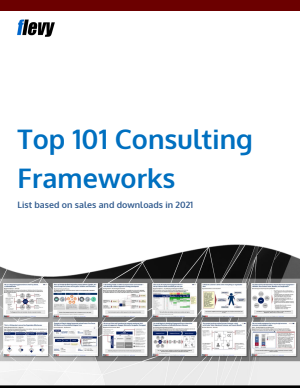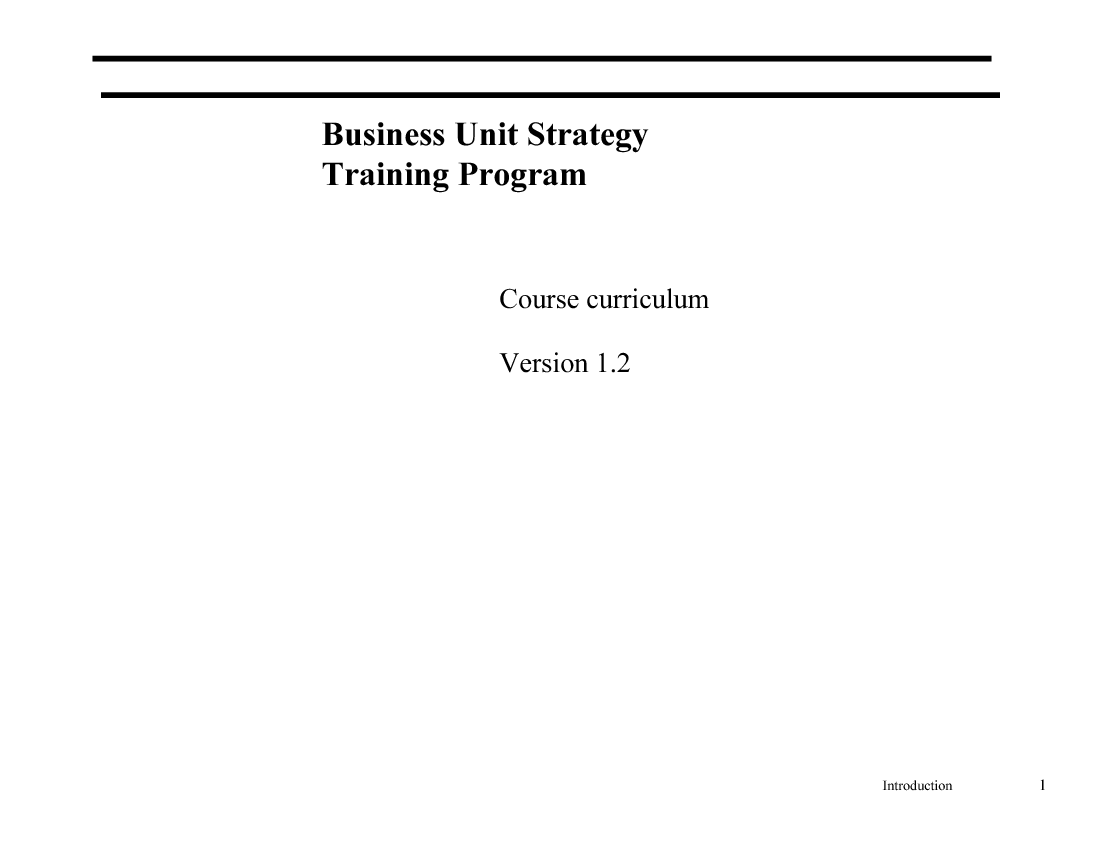







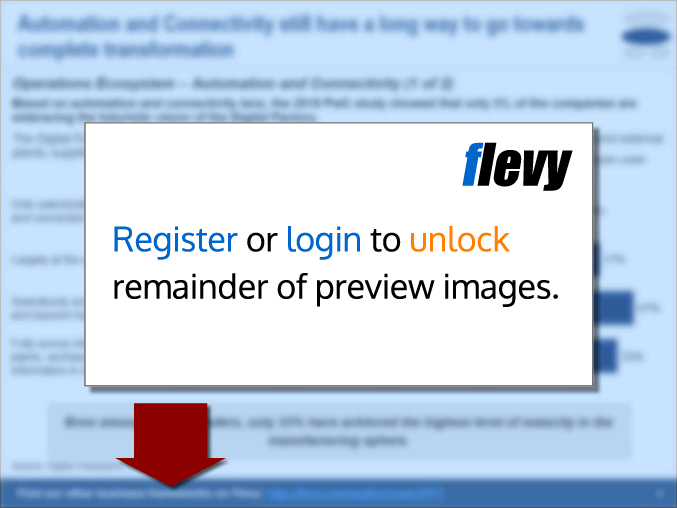








Please login here to save this document to a list.
If you don't have an account, you can register for free here.
Business Unit Strategy Training Program (PowerPoint PPT Slide Deck)
PowerPoint (PPT) 654 Slides
CONSULTING TRAINING PPT DESCRIPTION
This Training Program materials was developed a leading consulting firm aims Network with like-minded colleagues,Help make strategy capable, Develop skills in strategic analysis, Share and test experiences with others, Think about business issues from a strategic perspective. This program was created using a "bottom-up" approach, in which sources from around the firm and academia were gathered and with time filtered into the "finished product"
The objective of the training program is to teach a set of techniques that form the building blocks of analysis in strategy engagements and not to teach an approach. This program focuses on teaching techniques because there is not a standard approach to strategy. The training program focuses intensively on exercises and examples to ensure that the theoretical knowledge can be practically applied. The techniques taught in this program do not cover all of the areas that might be relevant in strategy projects
The training program focuses on BU strategy development methodology, consisting of 6 modules:
Module 1. Identification of key strategic issues
This module establishes the point-of-departure for business unit strategy engagements and categorized into Key issues of the engagement deliverable.
Module 2. Analysis of structure and dynamics of industry
This module teaches techniques and frameworks used to analyze the structure and dynamics of the industry and categorized into 5 deliverables include: Industry structure, Development of the industry, Product/market analysis, Demand and supply economics, Industry analysis frameworks
Module 3. Analysis of characteristics and dynamics of company
This module teaches the analysis of individual company characteristics and dynamics, which can be applied to both the client and its competitors and categorized into 5 deliverables include: Overall company profile, Product/market focus, Overview of the value chain, Financial resources and performance, Company analysis frameworks
Module 4. Assessment of execution capability
This module focus determine the degrees of strategic freedom available to the client in terms of the client's capacity to execute strategy. The purpose is that strategic decision-making should be tailored to the specific capabilities of the client. The module is categorized into Assessment of execution capacity deliverable
Module 5. Evaluation of strategic alternatives
Module 6. Implementation recommendation
Each module contains detail description of the considerations, methodology, key processes & activities, key tools/techniques, examples, deliverables, and usage. The deck has 600 PowerPoint slides.
The program also includes a comprehensive analysis of industry structure and dynamics, helping participants understand key market forces. You will gain insights into strategic group analysis, supply chain dynamics, and market segmentation.
Got a question about the product? Email us at support@flevy.com or ask the author directly by using the "Ask the Author a Question" form. If you cannot view the preview above this document description, go here to view the large preview instead.
Source: Best Practices in Consulting Training, Strategy Development, Industry Analysis, Environmental Analysis PowerPoint Slides: Business Unit Strategy Training Program PowerPoint (PPT) Presentation Slide Deck, Documents & Files
CONSULTING TRAINING PPT SLIDES
Understanding the Industry Life Cycle Stages

This PPT slide presents a life cycle analysis framework, illustrating how industries, products, or brands progress through 4 distinct stages represented by an S-shaped curve. The stages are Introduction, Growth, Maturity, and Decline, each characterized by specific sales patterns and strategic considerations.
In the Introduction phase, sales are low, costs are high, and the focus is on attracting innovators. This stage often involves significant investment in marketing to build awareness. As the product moves into the Growth phase, sales begin to rise rapidly, average costs decrease, and early adopters engage. This is where businesses typically see rising profits and a growing number of competitors entering the market.
The Maturity stage marks a peak in sales and profits, with a stable number of competitors. Here, companies must differentiate their offerings and may focus on segmentation strategies to maintain market share. The slide notes that this phase is characterized by high profits and a middle majority of buyers.
Finally, the Decline stage sees a downturn in sales and profits, with laggards remaining as the last buyers. Companies may need to consider strategies such as harvesting or divesting to manage declining revenues effectively. The assumptions listed emphasize that all industries have finite life spans and that each stage presents unique challenges requiring tailored strategies.
Understanding this life cycle is crucial for executives aiming to navigate their businesses through these phases effectively, ensuring that strategic decisions align with the current market dynamics.
Framework for Analyzing Industry Dynamics Using SCP

This PPT slide outlines a structured methodology for employing the Structure-Conduct-Performance (SCP) framework in industry analysis. It is divided into 4 key components: Input, Process, and Output, providing a clear pathway from data gathering to actionable insights.
The Input section lists various data sources and analytical tools necessary for a thorough examination. This includes supply and demand economics, expert interviews, and financial performance metrics. Such a comprehensive input phase ensures that the analysis is grounded in robust data, setting the stage for informed decision-making.
The Process is broken down into 4 sequential steps. The first step, "Study basic conditions," emphasizes understanding the foundational elements of the industry, including historical events and current dynamics. The second step, "Examine industry structure," focuses on analyzing the competitive environment, identifying recent changes, and linking these to external shocks. This step is crucial for grasping the underlying forces shaping the industry.
The third step, "Examine and predict conduct," involves assessing current behaviors and strategies of industry players while anticipating future conduct based on structural changes. This predictive aspect is vital for strategic planning. Finally, the fourth step, "Examine and predict performance," connects the dots between individual company performance and broader industry conditions, allowing for forecasts of future outcomes.
The Output section encapsulates the expected results of this methodology, which include a deep understanding of industry structure and evolution. This structured approach not only aids in identifying trends, but also equips executives with the insights needed for strategic positioning and long-term planning.
Strategic Decision-Making: Insights from the Prisoner's Dilemma
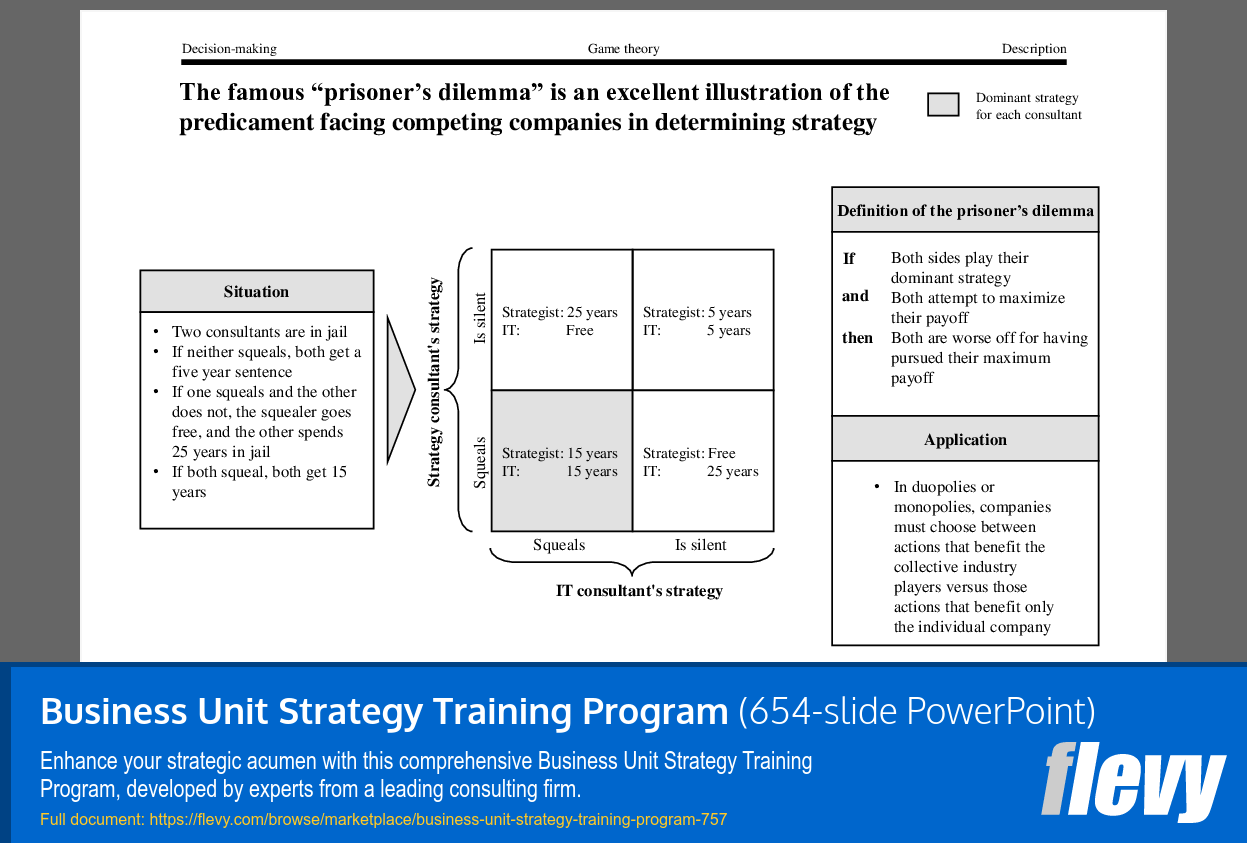
This PPT slide presents the "prisoner’s dilemma" as a framework for understanding strategic decision-making among competing companies. It outlines a scenario involving 2 consultants who face a choice that mirrors the strategic choices companies must make in competitive environments. The situation is clearly defined: both consultants are in jail, and their decisions to either remain silent or squeal lead to different outcomes based on their choices.
The matrix illustrates the consequences of their decisions. If both remain silent, they each serve 5 years. If one squeals while the other stays silent, the squealer goes free while the silent one faces a 25-year sentence. If both squeal, they each get 15 years. This setup emphasizes the tension between individual rationality and collective benefit, a core theme in strategic interactions.
The definition section clarifies that if both parties pursue their dominant strategies, they may end up worse off than if they had cooperated. This insight is critical for companies, as it highlights the potential pitfalls of self-serving strategies that neglect the broader industry context.
The application section extends the concept to real-world business scenarios, particularly in duopolies or monopolies. It suggests that companies must weigh the benefits of actions that serve their interests against those that might benefit the industry as a whole. This dilemma is particularly relevant in industries where collaboration could lead to better outcomes for all players involved.
Overall, the slide effectively encapsulates a complex strategic issue in a straightforward manner, making it a valuable resource for executives looking to navigate competitive dynamics.
Strategic Customer Segmentation for Coffee Refinery
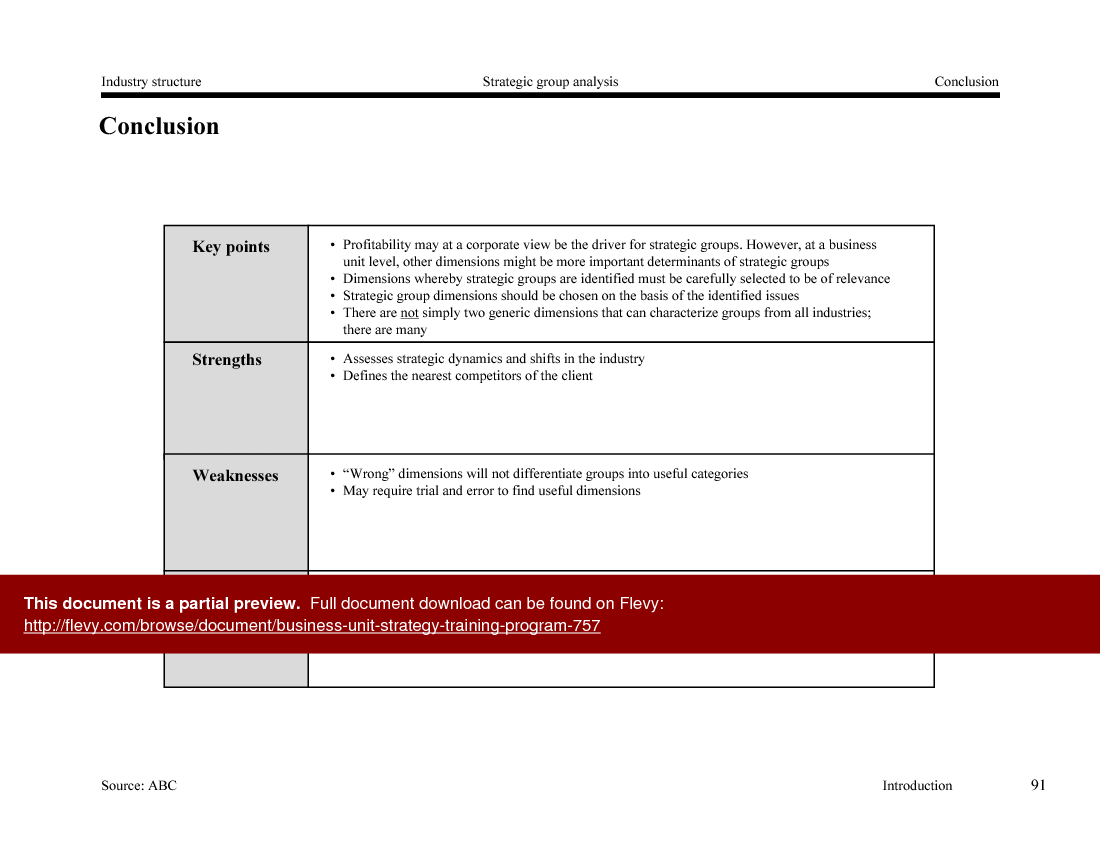
This PPT slide outlines a framework for customer-based strategies specifically tailored for a coffee bean refinery. It emphasizes the necessity of identifying target customer segments due to the inherent limitations in resources and the impracticality of reaching every potential customer. The central focus is on the customer, with various strategic elements branching out from this core.
The first element is "Segmentation by objectives," which highlights key factors such as high caffeine content, brand image, and taste preferences. These factors are critical in determining how to effectively position the product in the market. The segmentation process allows the company to align its offerings with the specific desires of different customer groups.
Next, the slide addresses "Targeted customers," indicating a focused approach towards specific demographics, particularly coffee connoisseurs in California and Oregon. This suggests a strategic decision to concentrate efforts on regions with a higher likelihood of demand, rather than spreading resources too thinly across a broader market.
The "Customer coverage" section further breaks down geographical segments, including the Northeast, South, and Midwest, alongside the primary focus on California and Oregon. This geographical segmentation is essential for optimizing marketing and distribution efforts, ensuring that the company can effectively meet the needs of its chosen customer base.
Overall, this slide serves as a practical guide for refining customer strategies in a competitive market. It underscores the importance of targeted segmentation and focused resource allocation, which can lead to more effective market penetration and customer satisfaction.
Six-Phase Iterative Process for Business Strategy
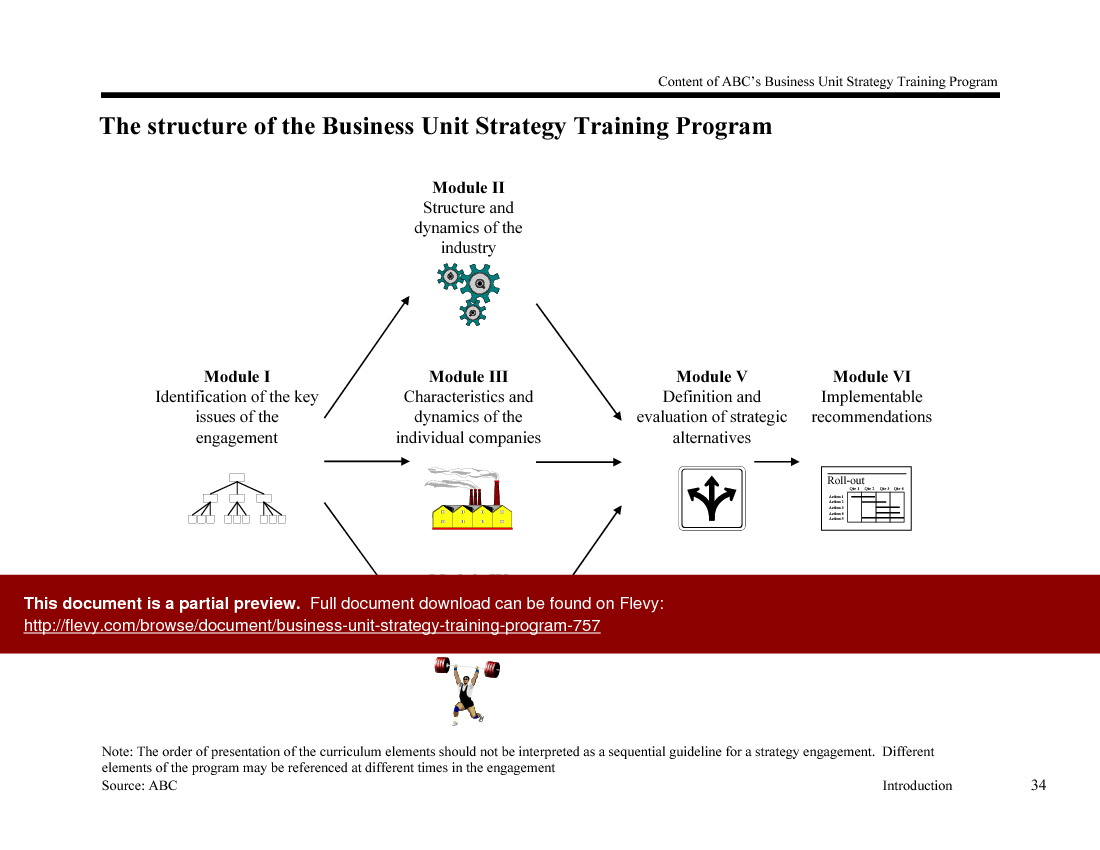
This PPT slide outlines a structured, six-phase iterative process for business unit strategy projects. It begins with a situation-complication-question analysis, which sets the stage for identifying key issues. Following this, the process moves into an issue breakdown phase, where various issues are dissected into sub-issues. This breakdown is crucial for a thorough understanding of the overarching challenges.
Next, hypotheses generation occurs, where potential explanations or solutions are proposed based on the identified issues. This is followed by evidence and fact gathering, which is essential for validating or refuting the hypotheses. The slide emphasizes the importance of collecting concrete data to support the analysis.
The development of findings and conclusions comes next, where the gathered evidence is synthesized to form coherent insights. This phase is critical as it translates raw data into actionable intelligence. Finally, the process culminates in recommendation formulation, where strategic suggestions are crafted based on the conclusions drawn.
The diagrammatic representation of the process highlights the flow from issues to recommendations, illustrating the interconnectedness of each phase. It suggests a methodical approach that ensures all aspects of the problem are considered, leading to well-founded strategic decisions. For potential customers, this slide serves as a clear roadmap of the analytical rigor and systematic methodology employed in business unit strategy projects, reinforcing the value of a structured approach in navigating complex business challenges.
Defining Core Ideology and Envisioned Future

This PPT slide presents a structured overview of how mission and vision statements articulate a company's core ideology and its envisioned future. At the center, the term "Mission/vision" anchors the discussion, indicating its foundational role in defining the organization’s identity.
The first section, labeled "Core ideology," emphasizes its importance in establishing the enduring character of the organization. It suggests that this ideology acts as a cohesive force, binding the organization together over time. This is crucial for maintaining stability and continuity in the face of change.
Next, "Core values" are highlighted as essential tenets that reflect the company's beliefs. These values are intrinsic, requiring no external validation, which underscores their fundamental role in guiding behavior and decision-making within the organization.
The "Core purpose" section elaborates on the organization's reason for existence. It captures the idealistic motivations that drive employees and reflects the essence of the company, distinguishing it from mere operational objectives.
The "10-30 year long-term goal" segment stresses the need for clarity and compelling challenges. It suggests that such goals should unify efforts across the organization and foster team spirit, indicating that a shared vision is vital for collective engagement.
Finally, the "Vivid description" component calls for a dynamic portrayal of what achieving long-term goals would entail. This vividness is essential for inspiring stakeholders and creating a tangible sense of direction.
Overall, the slide effectively encapsulates how mission and vision statements serve as critical tools for articulating a company’s identity and aspirations, providing a roadmap for future endeavors.
Understanding Cost Drivers through Economies of Scale

This PPT slide presents a framework for understanding how economies of scale can influence unit costs across different product categories, specifically in the context of copiers. It emphasizes the importance of identifying cost drivers associated with various activities, starting with those that incur the highest costs. The slide categorizes these drivers into 2 main types: structural drivers and executional drivers. This classification helps in pinpointing where efficiencies can be gained.
The graphical representation illustrates the relationship between unit costs and the number of units produced. As production volume increases, unit costs typically decrease, showcasing the benefits of economies of scale. The chart distinguishes between 3 categories of copiers: high-end, medium, and low-end. High-end copiers, which are characterized by high volume and high quality, show a significant reduction in unit costs as production scales up. Conversely, low-end copiers, which have low growth and volume, exhibit a less pronounced decrease in unit costs.
The slide underscores that understanding these dynamics is crucial for businesses aiming to optimize their cost structures. It suggests that by identifying the key cost drivers and their relationships to production volume, organizations can make informed decisions that enhance profitability. This approach is particularly relevant for executives looking to streamline operations and improve financial performance. Overall, the insights provided can guide strategic planning and operational adjustments to leverage economies of scale effectively.
Resource Allocation and Quality Assessment in IT Development
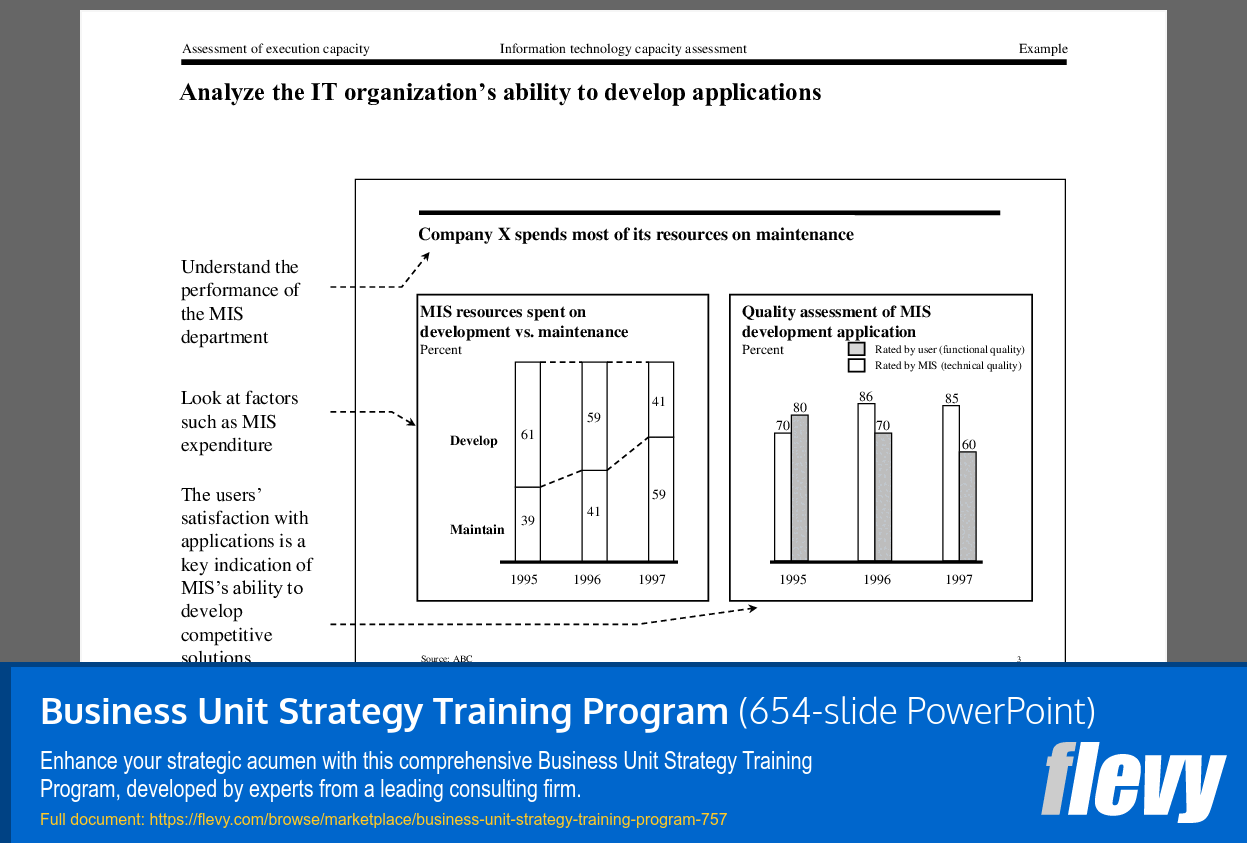
This PPT slide presents an analysis of Company X's IT organization's capacity to develop applications, focusing on resource allocation and quality assessment. The left section highlights the distribution of resources between development and maintenance. It indicates that in 1995, 61% of resources were allocated to development, while 39% went to maintenance. By 1997, the allocation shifted, with 59% dedicated to maintenance and only 41% to development. This trend suggests a growing emphasis on maintaining existing systems rather than investing in new development, which could hinder innovation and responsiveness to market demands.
The right section provides a quality assessment of the MIS development applications over the same years. It compares user ratings of functional quality against MIS's technical quality ratings. In 1995, user ratings were at 80%, while technical quality was rated at 70%. By 1996, user satisfaction improved to 86%,, but technical quality saw only a slight increase to 70%. In 1997, user ratings remained high at 85%,, but technical quality dropped to 60%. These figures indicate a potential disconnect between user satisfaction and the technical robustness of the applications, raising concerns about the sustainability of user satisfaction in the long term.
Overall, the slide underscores the critical balance between resource allocation for development and maintenance, alongside the importance of ensuring high-quality application performance. For decision-makers, this analysis serves as a call to reassess resource distribution and focus on enhancing both user and technical quality to foster a more agile and effective IT organization.
Impact Analysis of Scenarios on Auto Market Segments
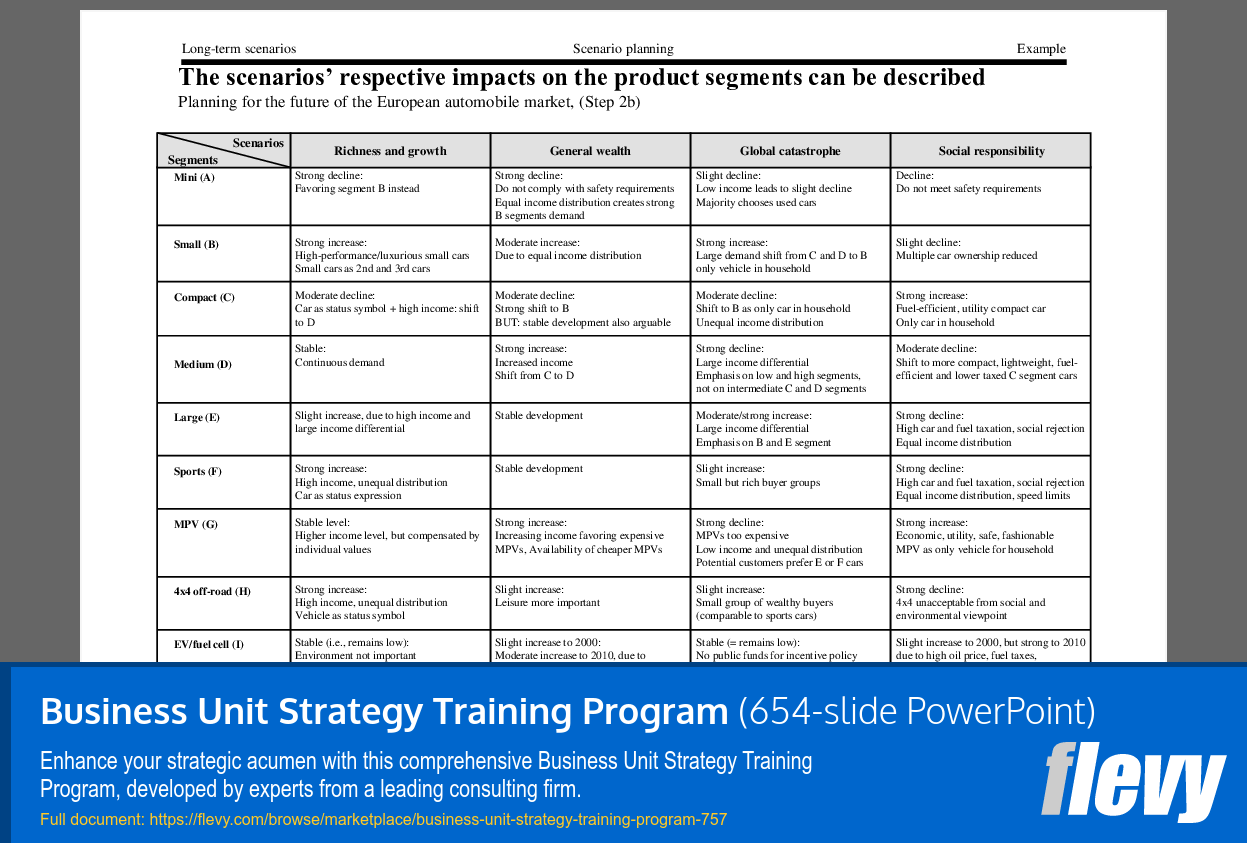
This PPT slide presents a detailed analysis of various scenarios impacting different segments of the European automobile market. Each segment is evaluated based on 3 primary factors: richness and growth, general wealth, and global catastrophe.
The Mini segment (A) is projected to experience a strong decline as consumer preference shifts towards segment B. This is attributed to safety compliance issues and income distribution trends. The Small segment (B) anticipates a strong increase, driven by demand for high-performance and luxurious small cars, alongside a shift in consumer behavior towards these vehicles.
Compact cars (C) are expected to see a moderate decline, influenced by their status as symbols of wealth. However, there is potential for stable development as the market shifts towards segment D. The Medium segment (D) remains stable with continuous demand, although there is an emphasis on shifting focus from C to D segments.
The Large segment (E) shows slight increases due to high-income consumers, while the Sports segment (F) is projected to grow strongly, appealing to affluent buyers. MPVs (G) are stable, but face challenges due to high costs, with a potential shift towards cheaper alternatives.
The 4x4 off-road segment indicates strong growth, particularly among wealthy buyers, while the EV/fuel cell segment remains stable with slight increases anticipated. However, environmental concerns and public incentives are crucial for future growth.
Overall, the slide provides a comprehensive overview of how varying economic conditions and consumer preferences will shape the future of the automobile market in Europe.
Value Capture Dynamics in the German Flour Supply Chain
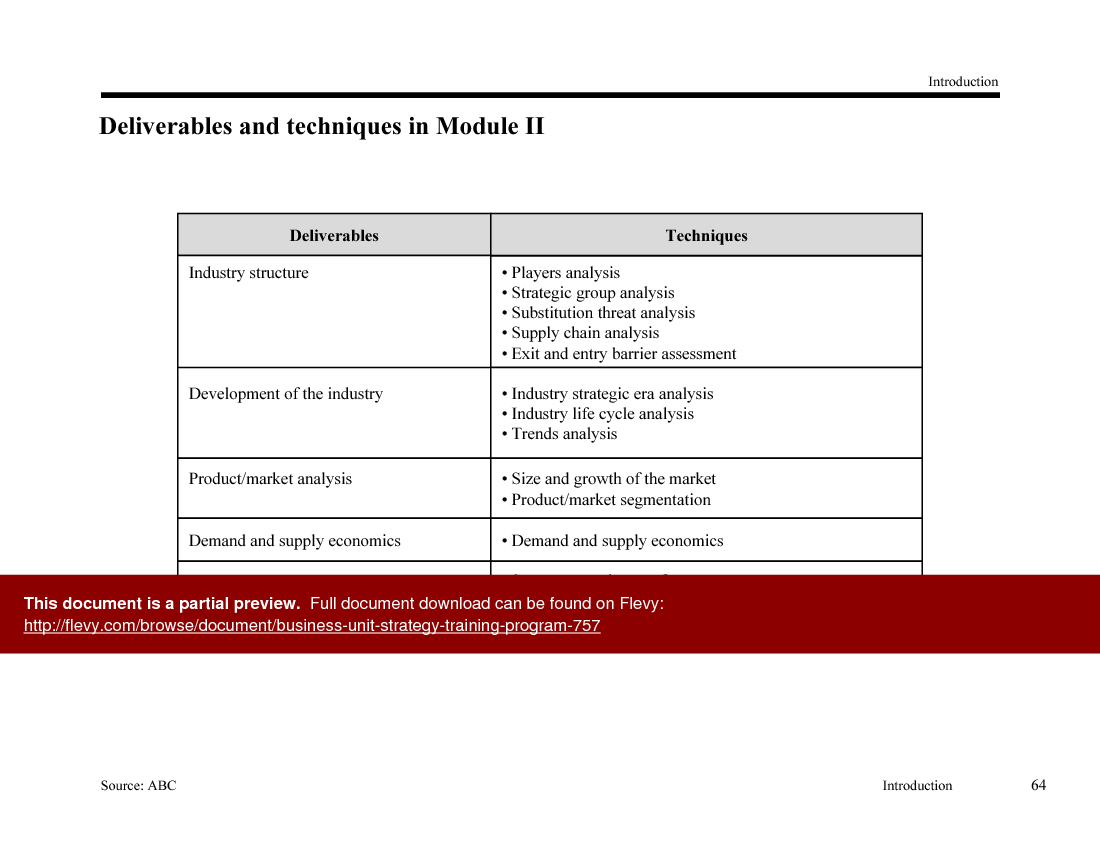
This PPT slide presents a supply chain analysis for the German flour industry, highlighting the diminishing value captured at each stage from 1990 to 1996. It visually breaks down the supply chain into key components: retailers, the client industry, transportation, and grain suppliers. Each segment is assigned a percentage of the total value, illustrating how the distribution of value has shifted over time.
The top section of the slide indicates that the overall value captured by the client’s industry has decreased from 1.50 DEM/kg in 1990 to 1.40 DEM/kg in 1996. This decline is significant, as it reflects a broader trend affecting the industry. The percentages next to each segment show the share of value retained by each player in the supply chain, with retailers capturing 29% in 1990, which increased to 32% by 1996. Conversely, the client industry saw a drop from 27% to 14%, indicating a loss of value over the same period.
Transportation and grain suppliers also show notable shifts, with transportation holding steady at 8% and grain suppliers increasing their share from 36% to 49%. The arrows and values on the right side of the slide provide a timeline perspective, emphasizing the changes in value capture over the years.
This analysis serves as a critical tool for understanding the dynamics within the supply chain and the implications for stakeholders. It highlights the need for strategic adjustments to reclaim lost value and adapt to the evolving market conditions. The visual representation aids in grasping complex relationships and trends, making it a valuable resource for decision-makers.
Framework for Evaluating Business Unit Strategy

This PPT slide outlines a framework for evaluating a client's business unit strategy, emphasizing the necessity of a clear and actionable approach to achieve success. It presents a structured methodology that consultants can employ to conduct an "acid test" on the client's strategic clarity. The slide is divided into 4 key components, each representing a critical aspect of a business unit strategy.
The first component focuses on the need for an integrated set of actions. It poses questions regarding the client's management of the value chain and whether their strategic plan encompasses all necessary actions. This indicates the importance of cohesion in strategy execution.
The second component addresses the design of the entire value system. It inquires about the effectiveness of the delivery mechanisms in meeting strategic objectives and the overall structure of the value system. This suggests that a well-designed value system is crucial for operational success.
The third component emphasizes the continuous creation and refinement of competitive advantages. Questions here revolve around the client's orientation towards business competition and the sustainability of their competitive edge. This highlights the dynamic nature of strategy in a competitive environment.
The final component centers on delivering superior customer value, with questions focusing on customer orientation and perceived value. This aspect underscores the necessity of aligning strategy with customer needs to drive long-term shareholder value.
Overall, the slide serves as a diagnostic tool for consultants, enabling them to assess whether a client’s strategy is robust enough to navigate challenges and capitalize on opportunities in the market.
Understanding Customer Switching Costs in Substitution
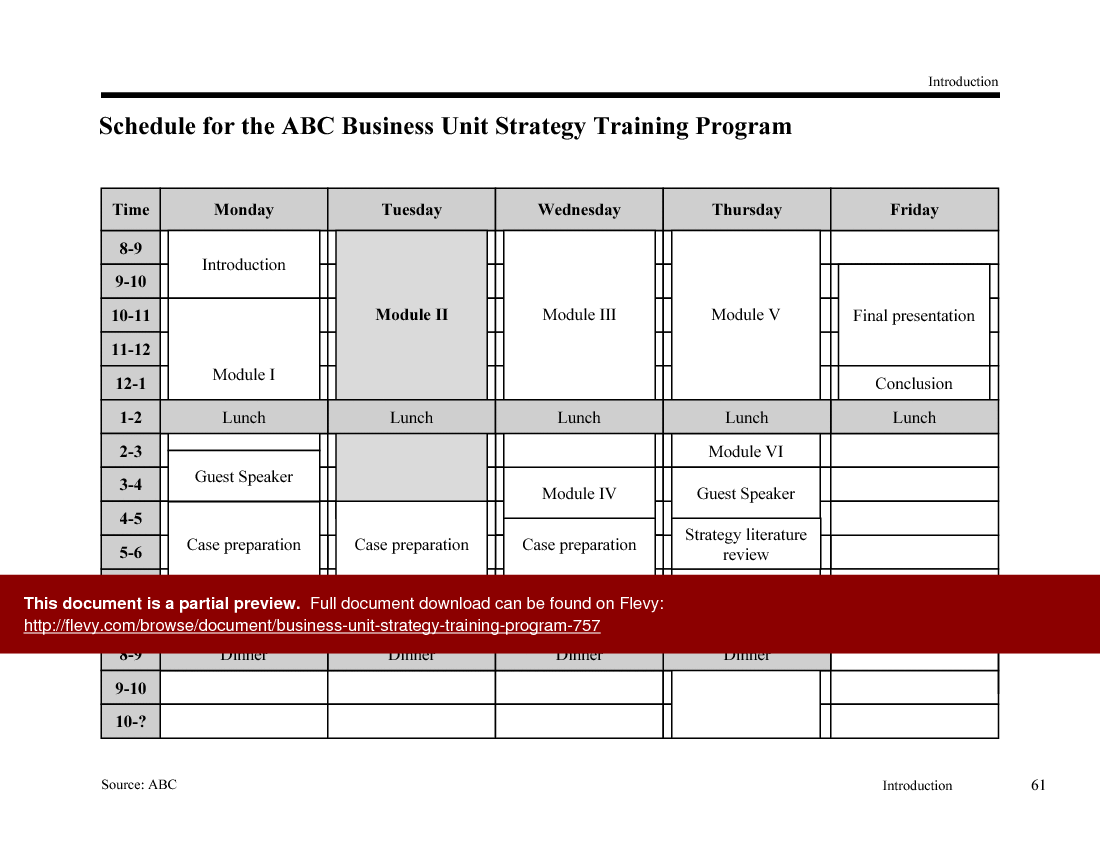
This PPT slide presents a detailed analysis of the costs incurred by customers when they switch between substitute products, specifically tailored for an international food manufacturer. It highlights various categories of switching costs, which are critical for understanding customer behavior and decision-making processes.
At the center of the slide is a box labeled "Switching costs," surrounded by several key components: installation costs, complementary product costs, complexity cost, service and maintenance costs, and decommissioning costs. Each of these elements represents a financial burden that customers face when transitioning from one product to another.
The slide emphasizes that addressing these switching costs is essential for companies not only when promoting their products as substitutes, but also when defending against competitors. This dual approach suggests that a comprehensive understanding of these costs can inform both marketing strategies and customer retention efforts.
The text also indicates that a subsequent step could involve quantifying each switching cost to assess its impact on the organization. This quantification could provide valuable insights into how these costs affect customer loyalty and purchasing decisions, ultimately influencing pricing strategies and product development.
Overall, the slide serves as a strategic tool for executives looking to enhance their understanding of customer dynamics in the context of product substitution. It encourages a proactive approach to managing switching costs, which could lead to improved customer satisfaction and retention.
Framework for Analyzing Entry and Exit Barriers

This PPT slide presents a framework for analyzing the impact of entry and exit barriers on industry performance. It highlights the relationship between these barriers and the profit potential for companies operating within various sectors. The positioning of industries is illustrated in a two-dimensional matrix, with entry barriers on the vertical axis and exit barriers on the horizontal axis.
In the upper right quadrant, where both entry and exit barriers are high, the slide notes that profit potential is significant,, but this comes with increased risk. Companies in this segment, such as multinational food players and aerospace manufacturers, face challenges in entering the market, while poorly performing firms find it difficult to exit. This creates a scenario where unsuccessful companies may remain in the market, intensifying competition.
The upper left quadrant indicates high entry barriers, but low exit barriers. This area is described as the most attractive segment, where few new entrants can penetrate the market, and companies that are underperforming can exit more easily. Local food players and dairy producers are examples of industries that fit this profile.
The lower quadrants illustrate scenarios with lower barriers. The lower left quadrant features industries with low entry and exit barriers, such as food stands and grocery stores, suggesting a more fluid market environment. Conversely, the lower right quadrant highlights industries like mining, where exit barriers are high, indicating that companies may struggle to leave even when conditions worsen.
This framework offers valuable insights for decision-makers considering market entry or exit strategies, emphasizing the need to evaluate both types of barriers to understand potential risks and opportunities.
Framework for Comprehensive Supply Chain Analysis

This PPT slide outlines a structured methodology for conducting a supply chain analysis, emphasizing a systematic approach to understanding the various components involved. It is divided into 2 main sections: Input and Output, with a central focus on 4 key steps in the analysis process.
The Input section lists essential data sources such as client interviews, annual reports, and expert interviews. This foundational data is crucial for identifying supply chain activities, which is the first step in the process. The methodology stresses the importance of defining the end product and the raw materials needed, as well as outlining the intermediate steps necessary to transform these materials into the final product. This clarity helps in understanding the entire supply chain framework.
Step 2 involves developing a value-added structure. This requires determining the value contributed at each stage of the supply chain. The analysis of selling prices, retail margins, and input costs is critical here. It allows for a deeper understanding of how each segment contributes to overall profitability.
The third step focuses on identifying the players involved at each stage of the supply chain. Grouping these players based on their product equivalency or substitutability is essential for assessing market dynamics.
The final step involves identifying relationships within and across the steps. This includes analyzing specific interactions among players and evaluating the degree of vertical integration. The Output section summarizes the expected deliverables, including linkages to suppliers, value-added analysis, and assessments of substitution threats.
This methodology provides a comprehensive framework for organizations looking to optimize their supply chain operations and understand the underlying dynamics that drive their business.
Understanding the Industry Demand Curve Dynamics

This PPT slide presents a fundamental concept in economics: the industry demand curve. It illustrates the relationship between price and quantity demanded for a specific product. The curve is downward sloping, indicating that as the price decreases, the quantity demanded increases, which is a standard behavior in market dynamics. Two price points, P1 and P2, are marked along the vertical axis, with corresponding quantities Q1 and Q2 on the horizontal axis. This visual representation helps in understanding how price fluctuations can impact consumer behavior and overall market demand.
To the right, a list outlines various factors that influence total quantity demanded. These include the product's price, the prices of substitutes or complements, product quality, consumer income, advertising efforts, and consumer tastes. Each of these elements plays a crucial role in shaping demand. For instance, if a substitute product becomes cheaper, the demand for the original product may decline. Similarly, effective advertising can enhance consumer awareness and preference, thereby increasing demand.
Understanding the demand curve is essential for strategic decision-making. It allows executives to anticipate how changes in pricing or market conditions might affect sales volumes. This insight can guide pricing strategies, marketing campaigns, and product development efforts. Overall, the slide serves as a foundational reference for executives looking to grasp essential economic principles that drive market behavior.
Evaluating R&D Investment Decisions with Decision Trees
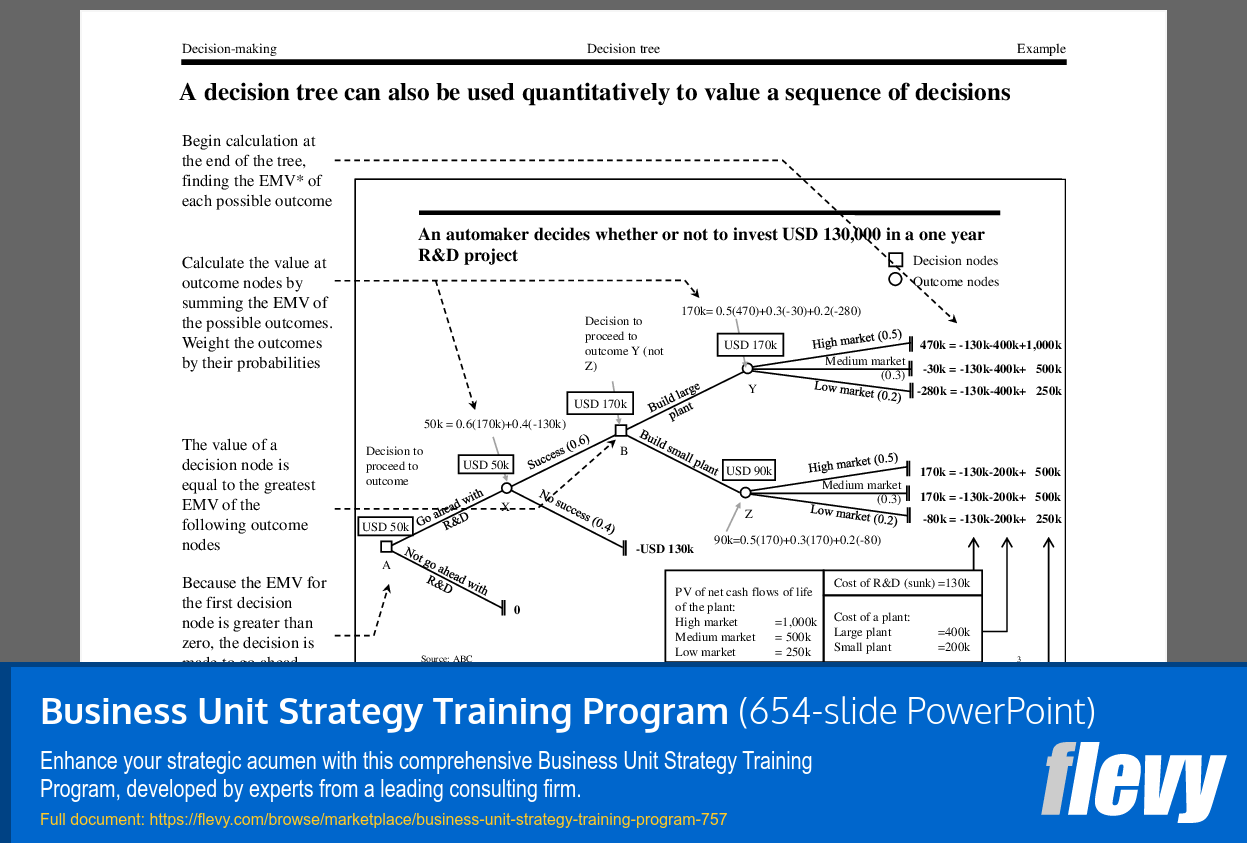
This PPT slide illustrates the application of a decision tree to evaluate an investment decision for an automaker considering a USD 130,000 R&D project. It emphasizes the importance of calculating the Expected Monetary Value (EMV) at various decision nodes to guide strategic choices. The process begins at the end of the decision tree, where the EMV for each outcome is determined.
The automaker faces a choice to proceed with the R&D investment or not. If they choose to proceed, they can either build a large plant or a small plant, each associated with different potential market outcomes. The outcomes are quantified in terms of monetary values, reflecting the projected cash flows in various market conditions—high, medium, and low.
Calculating the EMV involves summing the weighted outcomes based on their probabilities. For instance, the EMV for the large plant is calculated using the formula provided, which incorporates probabilities and potential cash flows. The decision tree visually represents these calculations, allowing for a clear comparison of potential paths.
The slide also highlights the significance of the initial decision node. If the EMV for this node is positive, it suggests that proceeding with the R&D is a favorable choice. The slide effectively communicates a structured approach to decision-making, providing a framework that can be applied to similar investment scenarios. This method not only clarifies potential financial outcomes, but also aids in risk assessment, making it a valuable tool for executives weighing significant investments.
Evaluating Auto Manufacturers' Market Segment Strengths
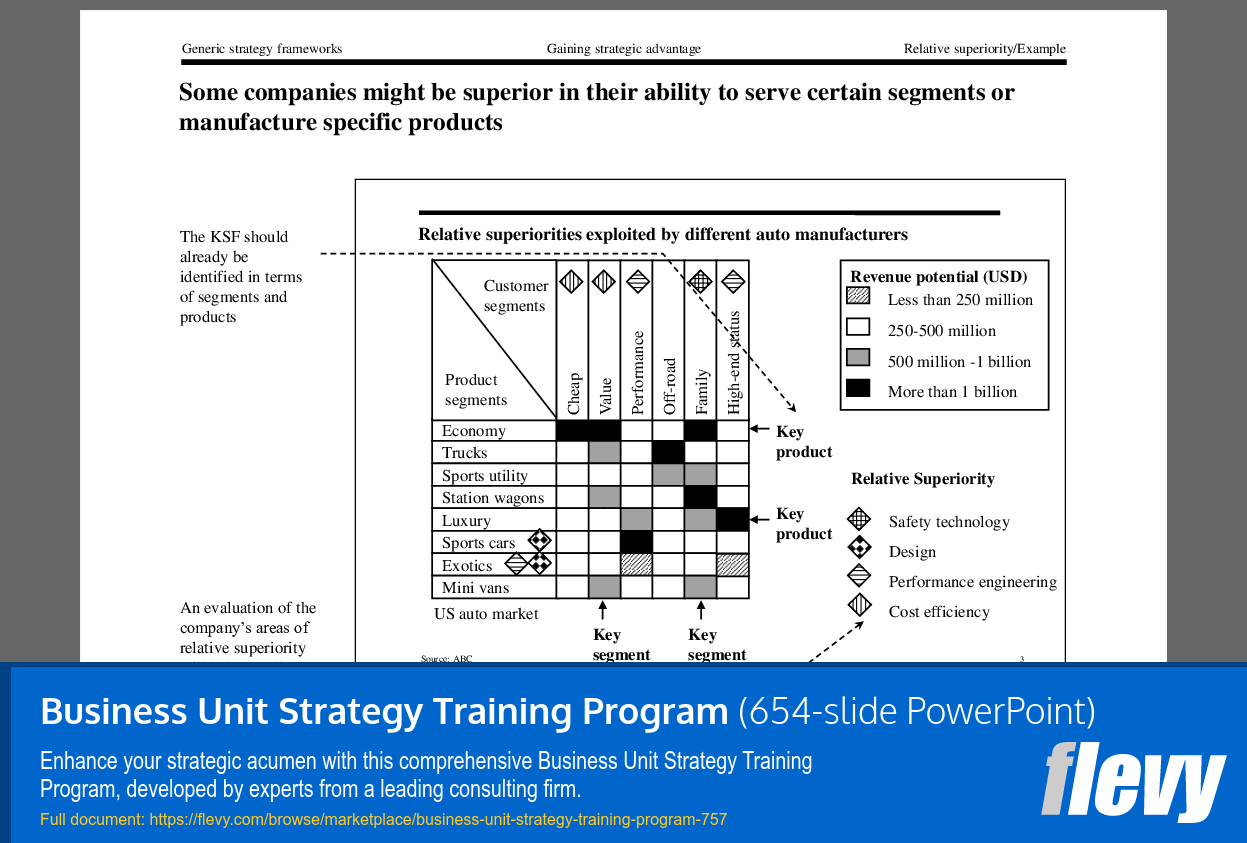
This PPT slide presents a framework for analyzing the relative strengths of various auto manufacturers in serving distinct market segments and product categories. It emphasizes that certain companies excel in specific areas, which can be crucial for strategic positioning. The grid layout categorizes customer segments against product segments, including economy, trucks, sports utility vehicles, and luxury cars. Each intersection highlights the performance of different manufacturers in these segments.
The slide notes that key success factors (KSFs) should already be identified based on the segments and products. This suggests that a thorough understanding of market dynamics is essential before making strategic decisions. The evaluation of a company's areas of relative superiority is crucial for identifying where it can effectively compete.
Revenue potential is illustrated through a color-coded system, indicating the financial viability of each segment. This provides a clear visual representation of which segments may offer the most lucrative opportunities. The terms "key product" are marked, indicating specific products that stand out within their respective segments.
Relative superiority is further detailed with categories such as safety technology, design, performance engineering, and cost efficiency. These attributes are essential for manufacturers to leverage in their marketing and operational strategies. The slide serves as a valuable tool for executives looking to assess their positioning in the automotive market, guiding them in resource allocation and strategic focus. Understanding these dynamics can lead to more informed decisions that align with market demands and company strengths.
Key Trends Shaping the Consumer Catering Industry
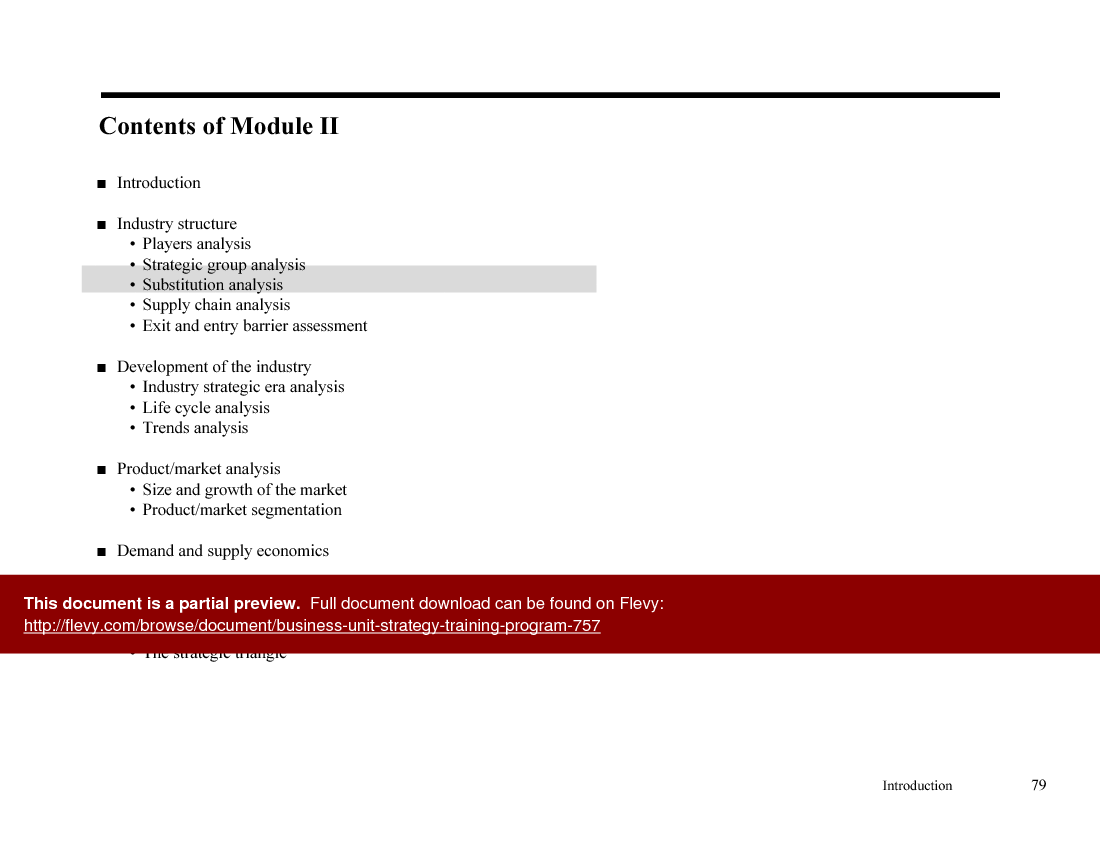
This PPT slide presents an analysis of key trends impacting the consumer catering industry, categorized into 3 sectors: fast food, restaurants, and hotel restaurants. Each sector is assessed for positive and negative trends, providing a comprehensive overview of the industry's current state and future potential.
In the fast food sector, several positive trends are highlighted. These include an increase in snacking habits, the strengthening of brand identity, and the growth of franchising models. Notably, there is a significant rise in consumption among the 25-35 age demographic, which suggests a shift in consumer preferences. However, this sector also faces challenges, such as the increasing popularity of home delivery services and supermarket pre-prepared foods, which could divert customers away from traditional fast food outlets.
The restaurant sector shows a demand for variety and choice, with customers increasingly seeking faster service and a broader selection of menu items. This trend is accompanied by a rise in the number of patrons visiting restaurants. Conversely, the sector is experiencing a reduction in average consumer spending per visit, smaller meal sizes, and a decline in drink consumption, indicating a shift in consumer behavior that may affect profitability.
In hotel restaurants, growth is linked to international travel, although some establishments have had to lower their prices to remain competitive. Negative factors include the impact of business entertainment cutbacks and a perception of being overpriced, which could deter potential customers.
Overall, this slide effectively synthesizes complex trends into a clear framework, enabling stakeholders to understand both opportunities and challenges within the consumer catering industry.
Evolution of the Consulting Industry: Key Trends and Players

This PPT slide outlines the evolution of the consulting industry over the past 2 decades, segmented into 3 distinct periods: 1980-1989, 1990-1997, and 1998 onward. Each period highlights external trends, the value proposition of consultants, key players, and factors critical for success.
In the first period, the primary external trend is the globalization of markets. Consultants focused on building strategy capabilities, emphasizing cost reduction and organizational design. Key players included established firms like McKinsey, BCG, Bain, and Booz Allen & Hamilton. Success hinged on problem-solving capabilities, which were essential for navigating the complexities of a globalizing economy.
The second period saw significant changes with deregulation, the convergence of industries, and the dismantling of conglomerates. The consultants' value proposition evolved to include industry knowledge and insights, as well as acting as process facilitators for operations and IT. Notably, ABC emerged as a key player alongside the established firms. Success factors shifted to include an international office network and industry practices, reflecting the need for consultants to adapt to a more interconnected world.
From 1998 onward, the focus transitioned to the digital world and the rise of virtual companies. The value proposition expanded to encompass end-to-end capabilities, indicating a shift towards comprehensive solutions. The key players now included the "Big Six" firms, highlighting a consolidation in the industry. Success factors evolved to include CEO control and integrated solutions, underscoring the need for strategic alignment at the highest levels of organizations.
This analysis provides a framework for understanding how consulting firms have adapted to changing market dynamics and client needs over time.
Defining Industry Scope: Four Levels of Competition
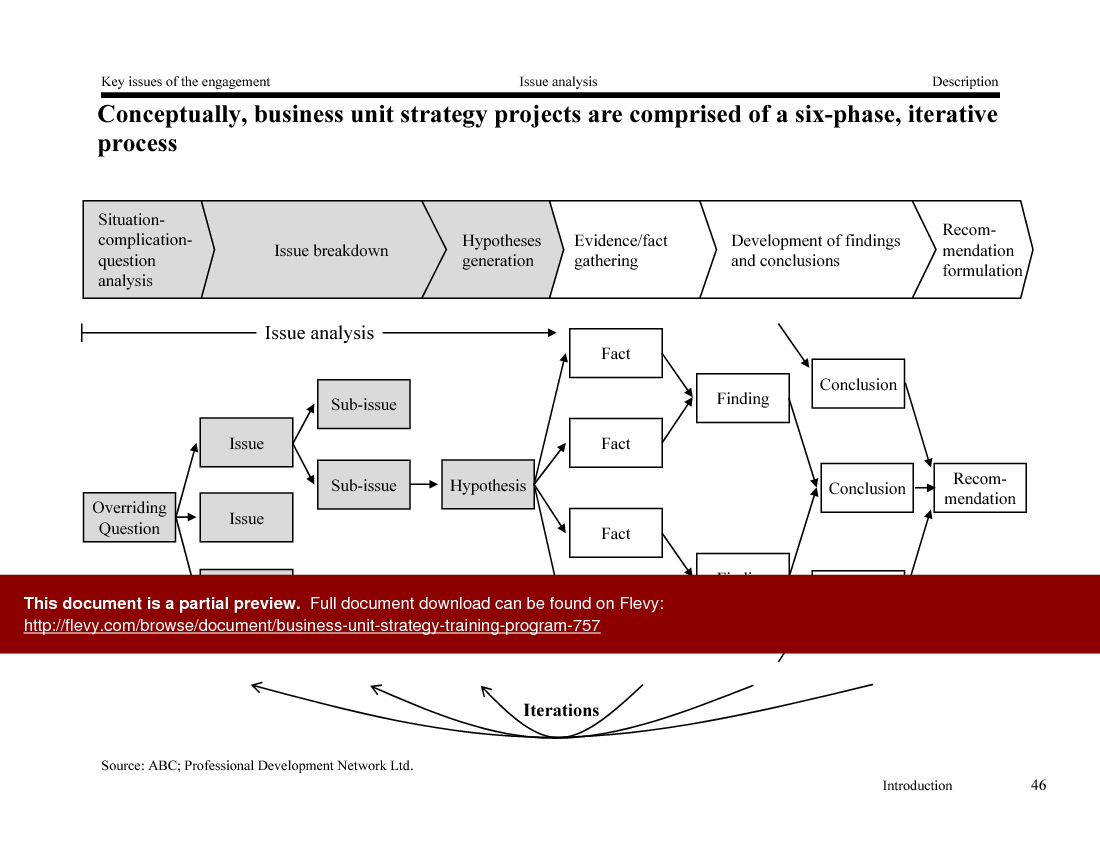
An industry can be conceptualized through 4 distinct levels, each offering a unique perspective on its scope and competition. This PPT slide outlines these levels, emphasizing the importance of viewpoint in defining industry boundaries.
At the top level, "Same products," we see a focus on manufacturers producing identical items, such as luxury automobiles from brands like Lincoln, BMW, Mercedes, and Lexus. This level is narrow, concentrating on direct competitors within a specific product category.
The second level, "Similar product or product range," broadens the definition to encompass all automobile manufacturers. This perspective captures a wider array of competition, recognizing that various brands may offer similar vehicles, even if they differ in features or branding.
The third level, "Products that serve same needs," expands further to include not just cars, but also manufacturers of motorcycles, bicycles, and trucks. This level reflects a more holistic view of consumer needs, acknowledging that different types of vehicles can fulfill similar purposes for customers.
Finally, the lowest level, "Products competing for the spending of the same customer group," takes an even broader approach. Here, the focus shifts to all companies selling major consumer durables, such as homes and household appliances. This level illustrates how industries can overlap significantly in terms of consumer spending, regardless of the specific product.
Understanding these levels is critical for strategic decision-making. It helps executives identify potential competitors and market opportunities that may not be immediately apparent. Each perspective offers insights that can guide product development, marketing strategies, and overall business positioning.
Variants of Industry Life Cycles Explained

This PPT slide presents various industry life cycle models, emphasizing that actual cycles often deviate from theoretical expectations. Each model illustrates distinct patterns of sales over time, highlighting how different products or trends evolve.
The "Growth-slump-maturity" model indicates that sales can stabilize at a low level after initial growth, driven by early adopters transitioning to late adopters. This model is particularly relevant for niche products, such as small kitchen appliances, where a steady demand can be maintained despite overall market fluctuations.
The "Cycle-recycle" model suggests that as sales decline, companies may reinvigorate interest through new promotional efforts. This cycle is typically smaller in scale and duration compared to the primary cycle, as seen in the pharmaceutical industry where drugs are promoted repeatedly to sustain sales.
The "Style" model describes a basic mode of expression that can persist over generations. Styles may experience fluctuations in popularity, reflecting changing consumer preferences in areas like fashion and home decor.
The "Fashion" model outlines a more structured progression, where a style becomes popular, undergoes mass adoption, and eventually declines. This model captures the lifecycle of trends, such as denim jeans, which illustrate how fashions can grow slowly before reaching peak popularity.
The "Fad" model represents a rapid rise and fall in popularity, characterized by brief, intense consumer interest. Fads, like pet rocks, often lack enduring appeal and fail to meet strong consumer needs.
Understanding these variants equips executives to anticipate market dynamics and adapt strategies accordingly. Each model provides insights into consumer behavior and the potential longevity of products in various sectors.
Evaluating Confectionery Customer Segments by Expenditure
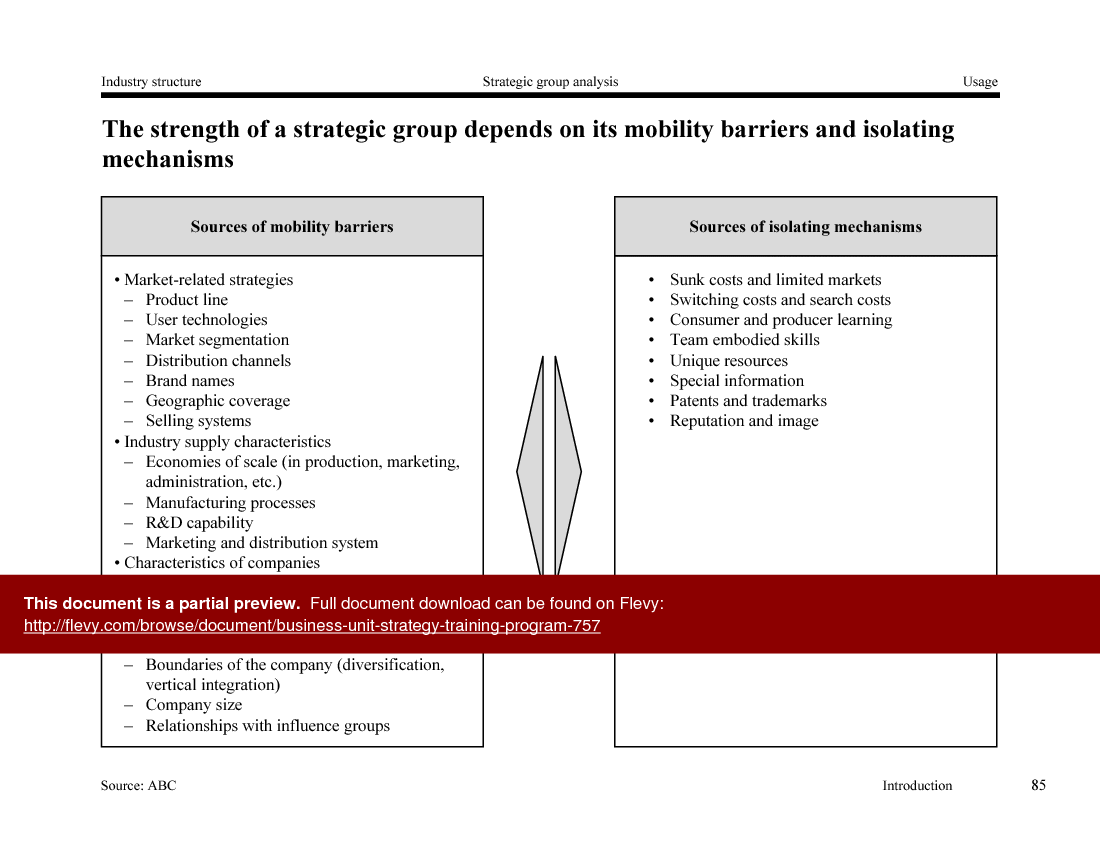
This PPT slide presents a product and market analysis focused on confectionery customer segments, specifically their expenditure on pick & mix products. It illustrates the relationship between the percentage of the movie-going population and their corresponding expenditure on these products. The graph categorizes 4 distinct segments, each representing a different level of attractiveness based on their spending behavior.
Segment 1, positioned at the highest expenditure level, indicates that a small percentage of the population contributes significantly to total sales. This suggests that targeting this segment could yield substantial returns. Segment 2 follows closely, showing a moderate level of expenditure. Segment 3 and Segment 4, however, represent lower expenditure levels, indicating they are less attractive for focused marketing efforts.
The visual representation emphasizes that a small proportion of the population (20% of movie-goers) accounts for a disproportionate share of confectionery sales (57%). This insight highlights the importance of identifying and prioritizing segments that generate the most revenue. The slide effectively communicates that once segments are identified, their economic potential must be evaluated to inform strategic decisions.
Understanding these dynamics can guide marketing strategies, product offerings, and resource allocation. The analysis encourages executives to consider not just the size of each segment, but also their spending habits, which can significantly impact overall profitability. This approach ensures that efforts are concentrated on the most lucrative segments, ultimately driving growth and enhancing market positioning.
Structured Methodology for Issue Analysis
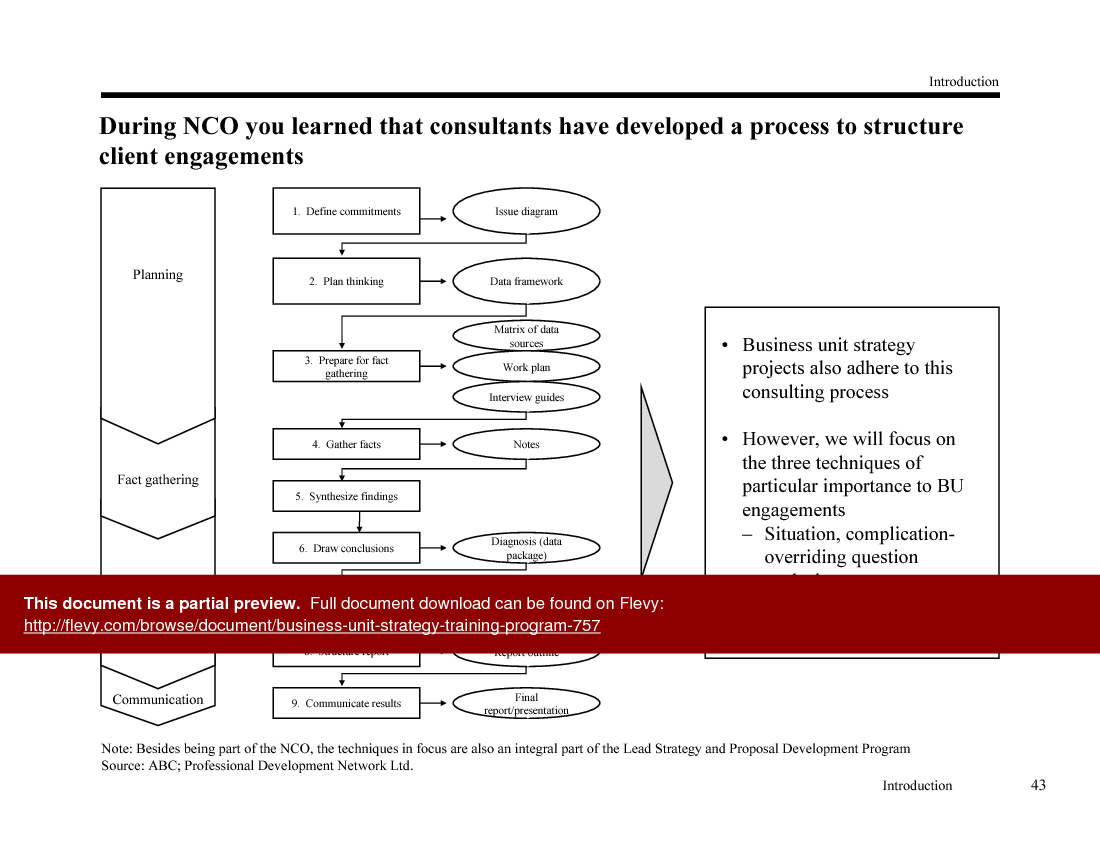
This PPT slide outlines a structured methodology for conducting issue analysis, emphasizing a systematic approach to problem-solving. It begins with an "Input" section that lists various sources of information, including client requests, annual reports, and expert interviews. This foundational data is crucial for understanding the context and specifics of the client's situation.
The methodology is divided into 4 key steps, each representing a phase in the analysis process. The first step, "Situational analysis," focuses on studying the client and their industry. It involves reaching a consensus on the current situation and defining the primary complications and overarching questions that need to be addressed. This phase sets the stage for deeper exploration.
Next, the "Brainstorm and issue breakdown" phase encourages a collaborative effort to identify all potential questions and issues. This step aims to prevent the analysis from becoming too narrow and ensures all relevant aspects are considered. It also emphasizes reaching consensus among team members and the client on the issues at hand.
The third step, "Hypotheses generation," is about formulating testable explanations for each identified issue. This involves making informed guesses to guide further investigation, ensuring that the hypotheses align with the overarching question defined earlier.
Finally, the "Formulate project plan" phase focuses on operationalizing the insights gained. It includes determining necessary analyses, delegating responsibilities, and establishing timelines. The output of this methodology is a unified project plan that aligns the team and client on the objectives and structure for the analysis.
This slide provides a clear framework for understanding how to approach complex issues methodically, ensuring that all relevant factors are considered and that the project is well-organized from the outset.
Focus on Business Unit Strategy Development

This PPT slide outlines the focus of a training program centered on business unit strategy, distinguishing it from corporate and functional strategies. It emphasizes that while strategy can cover a broad range of areas, this program specifically targets how a business unit operates within its industry.
At the top, the slide categorizes strategy into 3 levels: industry, corporate, and business unit. The industry section highlights strategies for restructuring, suggesting a need for adaptability in changing market conditions. The corporate segment defines the scope of the company, detailing how various business units fit into different industries and markets. This indicates a strategic alignment across the organization.
The business unit strategy is defined as the approach a company takes to compete within a specific market. This section is critical as it connects to market and competitive strategies, which are essential for understanding positioning and differentiation. The slide also introduces functional strategy, which deals with the operational aspects of resource deployment, including R&D, personnel, finance, production, and sales. This suggests that effective execution at the business unit level requires a clear understanding of how these functions interact with the overarching strategy.
The visual layout, with arrows and boxes, indicates a flow of thought from broader strategic considerations down to specific operational tactics. This structure reinforces the idea that effective strategy is multi-layered and requires coherence between different strategic levels. The training program aims to equip participants with the tools to navigate these complexities effectively, enhancing their strategic acumen within their respective business units.
Strategic Analysis of Industry Players and Their Dynamics

This PPT slide presents a structured analysis of various players within an industry, focusing on their current strategies, objectives, and capabilities. It is divided into 3 main sections: Current Strategy, Objectives, and Capabilities, each providing critical insights for decision-makers.
The Current Strategy section outlines 2 key components: Strategic Intent and Realized Strategy. Strategic Intent refers to the overarching goals and direction a company aims to pursue, while Realized Strategy encompasses tangible actions such as capital investments, product lines, mergers, and marketing efforts. This dual perspective helps in understanding not only what a company aspires to achieve, but also how it is executing those aspirations.
Moving to Objectives, the slide prompts critical questions regarding performance metrics. It asks whether the current performance aligns with objectives related to profitability, market share, growth, and research and development. The consideration of future changes in objectives is also highlighted, indicating a need for adaptability in strategy.
The Capabilities section assesses the potential challenges posed by competitors. It emphasizes the importance of evaluating financial reserves, capital equipment, workforce, brand loyalty, management quality, and alliances. This assessment is crucial for understanding the competitive pressures that may arise and how they could impact strategic positioning.
Overall, the slide serves as a comprehensive framework for evaluating industry players, offering insights that are essential for strategic planning and competitive analysis. It encourages executives to think critically about both their own strategies and those of their competitors, ensuring informed decision-making.
Buyer Behavior Analysis for Product Switching
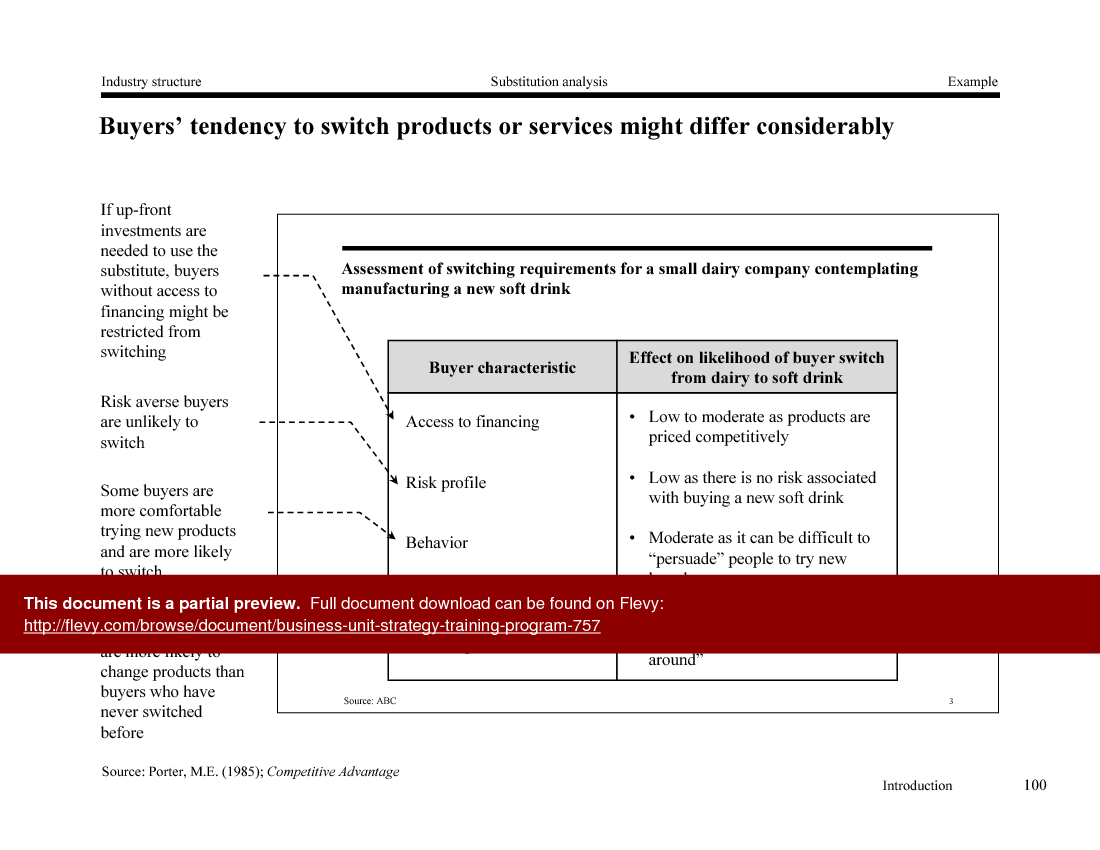
This PPT slide presents an analysis of buyer behavior regarding the likelihood of switching from dairy products to a new soft drink. It highlights that various buyer characteristics significantly influence this tendency.
The first characteristic discussed is "Access to financing." Buyers lacking financial resources may face barriers when considering a switch. The text suggests that if upfront investments are necessary to adopt the new product, those without financing options may be restricted from making the change. This indicates that financial accessibility plays a crucial role in the decision-making process.
Next, the "Risk profile" of buyers is examined. Risk-averse individuals are less likely to switch products, as they tend to prefer the familiarity of their current choices. The slide notes that for buyers who perceive low risk in trying a new soft drink, the likelihood of switching increases. This implies that minimizing perceived risk can be a strategic approach for companies looking to attract new customers.
Lastly, the "Behavior" of buyers is addressed. Some consumers are more open to experimenting with new products, which can enhance their likelihood of switching. The slide points out that while competitive pricing can facilitate this transition, persuading buyers to try something new can still be challenging. This underscores the importance of marketing strategies that effectively communicate the benefits of the new product.
Overall, the slide provides valuable insights into how different buyer characteristics can affect their willingness to switch products. Understanding these dynamics is essential for any company aiming to successfully introduce new offerings in a competitive market.
Structured Approach to Client Engagements in Consulting
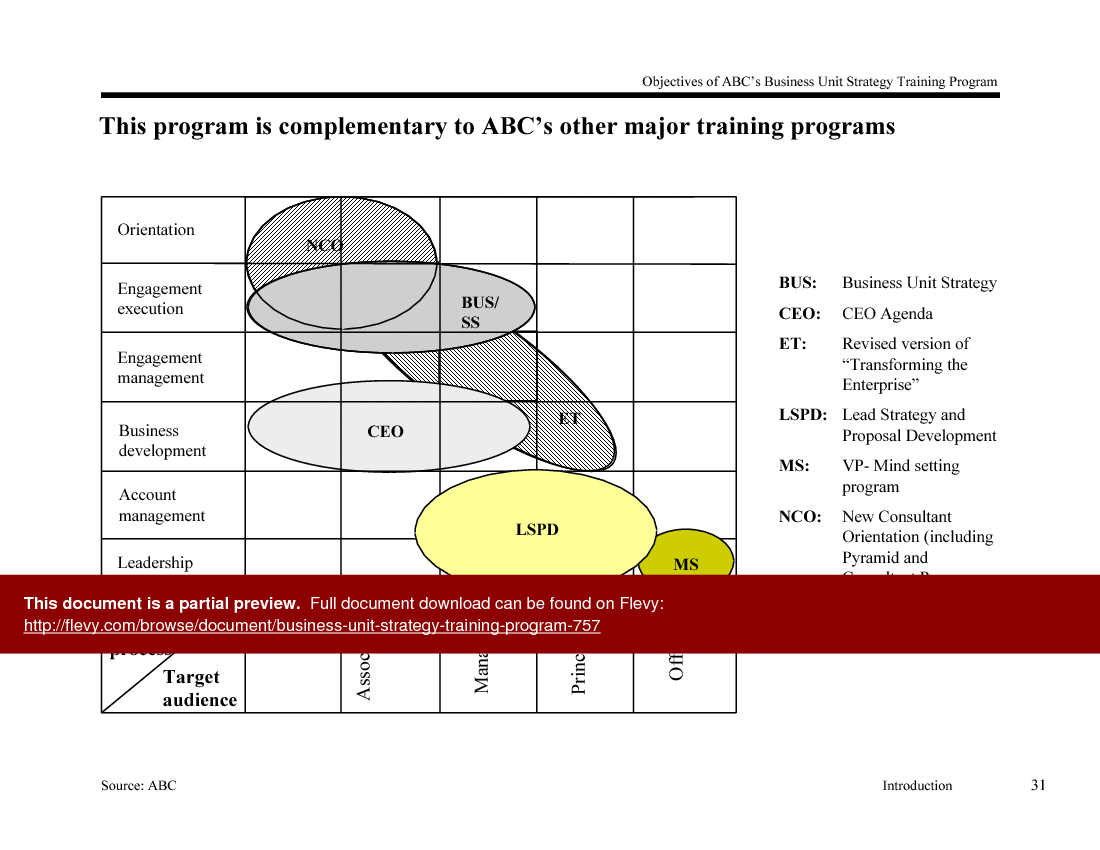
This PPT slide outlines a structured approach that consultants utilize to manage client engagements effectively. It begins with the "Planning" phase, where the first step is to define commitments, followed by planning thinking. This sets the groundwork for a systematic process that ensures all aspects of the engagement are addressed.
The next phase is "Fact gathering," which involves preparing for data collection, gathering facts, and synthesizing findings. This is crucial, as it lays the foundation for informed decision-making. The slide highlights the importance of various tools, such as issue diagrams and data frameworks, which help organize information and clarify objectives.
Following the fact-gathering stage, the "Analysis" phase comes into play. Here, conclusions are drawn based on the collected data, leading to the generation of recommendations. This step is vital for translating insights into actionable strategies. The final steps involve structuring the report and communicating results, ensuring that findings are presented clearly and effectively to stakeholders.
The slide also emphasizes that business unit strategy projects align with this consulting process. It points out a focus on 3 specific techniques that are particularly relevant to business unit engagements: situation analysis, complication-overriding question analysis, and issue breakdown. These techniques are essential for addressing complex challenges and generating hypotheses that guide strategic decisions.
Overall, the slide provides a clear framework for understanding how consultants approach client engagements, emphasizing the importance of structured processes in achieving successful outcomes. This structured methodology can be beneficial for organizations looking to enhance their strategic initiatives.
Enhancing Strategic Capabilities for Operational Excellence

This PPT slide presents an assessment of ABC's current capabilities, emphasizing the need for enhancement in its strategic functions to achieve end-to-end operational effectiveness. The central focus is on 3 key areas: Strategy, Operations, and Information Technology, each rated on a scale from 1 to 5.
ABC's strategy capability is notably rated at a 2, indicating significant room for improvement. This suggests that while the organization may have established some strategic frameworks, they are not sufficiently robust to support comprehensive operational integration. In contrast, both Operations and Information Technology are rated at a 5, reflecting strong capabilities in these areas. This disparity highlights a critical gap; while ABC excels in executing operations and leveraging technology, its strategic framework lacks the necessary strength to unify these functions effectively.
The slide also includes a statement about the "Need for improvement on a global basis," which suggests that the issues identified are not isolated, but rather systemic, affecting the organization’s overall performance. This points to a potential risk if the strategic capabilities are not addressed, as it may hinder ABC's ability to capitalize on its operational strengths and technological advancements.
For potential customers, this slide serves as a clear call to action. It underscores the importance of investing in strategic development to ensure that operational and technological capabilities are aligned and leveraged effectively. Addressing this gap could lead to enhanced performance and a more cohesive approach to achieving organizational goals.
Framework for Assessing IT Capabilities in Business

This PPT slide outlines a structured approach to assessing a company's IT capabilities through the Jupiter framework, emphasizing the importance of aligning IT with business strategy. It presents a five-phase process that begins with "Foresight," where organizations are prompted to consider how IT influences their overall strategy. This phase sets the stage for deeper exploration into IT's role within the business context.
The next phase, "Insight," addresses the need for clarity regarding specific IT challenges and opportunities. Here, stakeholders are encouraged to seek a better understanding of their current IT landscape. Following this, the "Plan" phase emphasizes the necessity of developing a strategic approach to tackle identified challenges. It suggests that organizations should not only recognize issues, but also formulate actionable plans.
The "Implementation" phase highlights the need for leadership during the execution of IT strategies. It indicates that having a plan is insufficient without strong guidance to ensure successful implementation. Lastly, the "Hindsight" phase focuses on the importance of reflection and assurance post-implementation, ensuring that the outcomes align with initial expectations and objectives.
This structured framework serves as a roadmap for organizations aiming to enhance their IT capabilities in alignment with business goals. It provides a clear progression from understanding the impact of IT to executing and reflecting on IT strategies. For potential customers, this slide illustrates a comprehensive approach that can lead to more effective IT management and alignment with broader business objectives.
Mapping Value and Cost of Dairy Product Substitutes
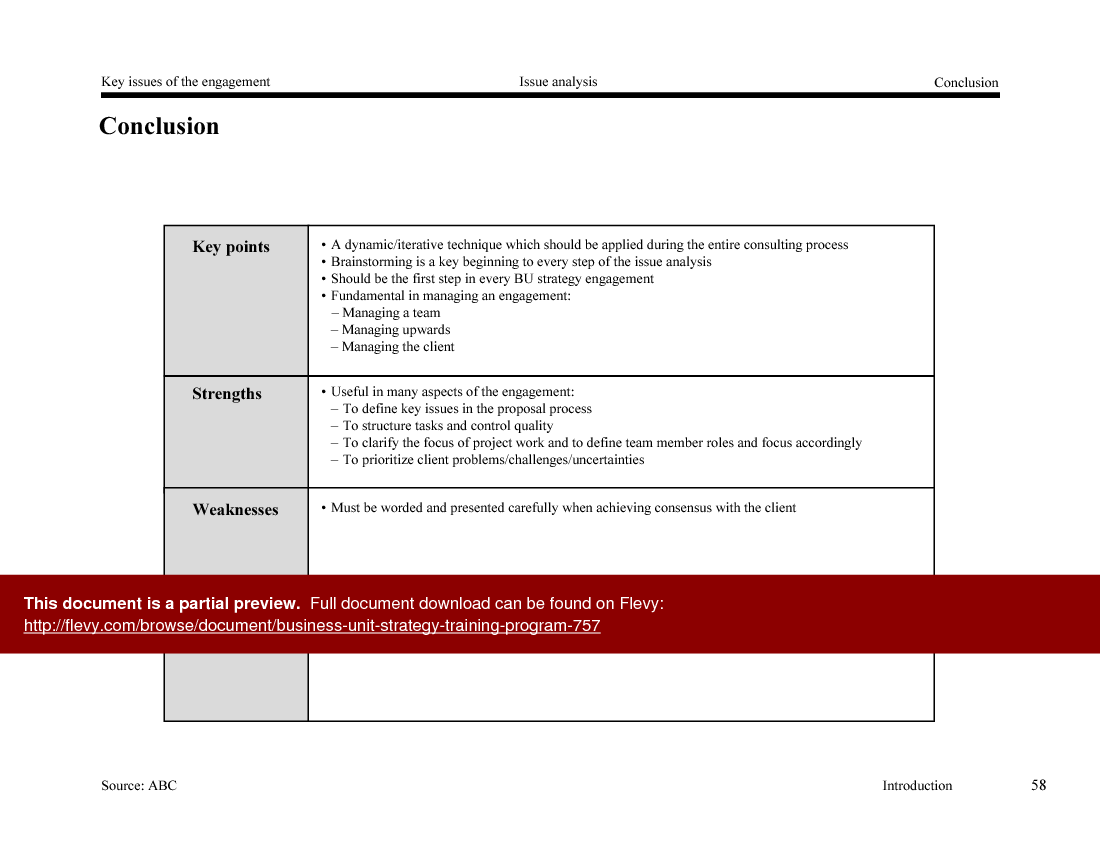
This PPT slide presents a value/cost matrix designed to analyze product substitutes within an industry, specifically dairy products in this case. The matrix visually represents how different products (S1 to S6) relate to customer value and cost. The vertical axis indicates the value to the customer, while the horizontal axis denotes the cost incurred by the customer.
Products S1 and S3 are highlighted as delivering the most value relative to their cost, positioning them as optimal choices for customers. This suggests that these products effectively meet customer needs while maintaining a favorable cost structure. The diagonal line in the matrix indicates a balance point where value equals cost, serving as a benchmark for evaluating other products.
Products S1, S2, S3, and S4 are noted to provide more value than their cost, indicating that they are likely to be perceived positively by customers. Conversely, S5 and S6 are positioned in a way that suggests they cost more than the value they deliver. This could imply a risk of losing customer interest or market share, as consumers seek better value options.
The slide emphasizes the importance of understanding how products stack up against one another in terms of value and cost. It encourages businesses to consider substitution threats posed by high-value, low-cost products. This analysis can guide strategic decisions regarding product development, pricing, and marketing efforts to enhance customer satisfaction and retention. Overall, the matrix serves as a useful tool for visualizing and assessing product positioning in a competitive market.
Iterative Issue Analysis Framework for Client Engagement
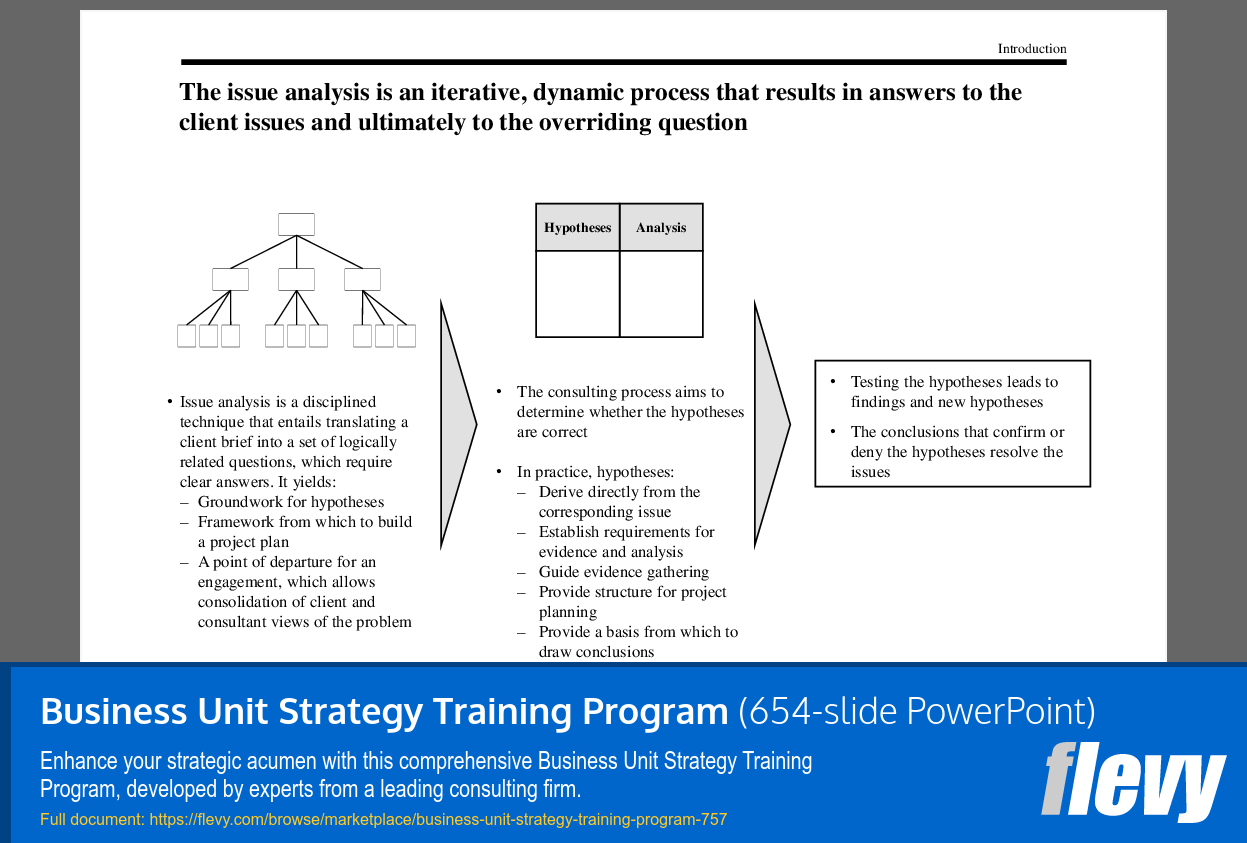
This PPT slide presents a structured approach to issue analysis, emphasizing its iterative and dynamic nature. It begins by defining issue analysis as a disciplined technique that translates a client brief into logically related questions, which are essential for deriving clear answers. The left section outlines the outputs of this process, which include groundwork for hypotheses, a framework for project planning, and a consolidated view of the client and consultant perspectives on the problem.
The central part of the slide focuses on the hypotheses and analysis components. It highlights that the consulting process is designed to validate the proposed hypotheses. These hypotheses should stem directly from the identified issues, establishing clear requirements for evidence and analysis. This section also notes that the hypotheses guide the evidence-gathering process and provide a structured approach for project planning.
On the right side, the slide discusses the outcomes of testing the hypotheses. It indicates that this testing leads to findings and potentially new hypotheses, creating a feedback loop that enhances understanding. The conclusions drawn either confirm or deny the initial hypotheses, ultimately resolving the client issues at hand. This cyclical process ensures that the analysis remains relevant and responsive to the evolving nature of client needs.
Overall, the slide effectively communicates the importance of a systematic approach to issue analysis in consulting, illustrating how it leads to actionable insights and resolutions for client challenges.
Comprehensive Schedule for Business Unit Strategy Training

This PPT slide outlines a structured schedule for the ABC Business Unit Strategy Training Program, spanning 5 days. Each day is divided into specific time slots, detailing various modules, activities, and breaks. The program begins with an introductory session on Monday morning, setting the stage for the subsequent modules.
Modules I through VI are strategically placed throughout the week, indicating a progressive learning approach. Each module likely builds on the previous one, enhancing participants' understanding of business unit strategy. The inclusion of guest speakers on multiple days suggests a focus on real-world insights, providing attendees with diverse perspectives from industry professionals.
Lunch breaks are consistently scheduled, allowing participants to network and reflect on the morning sessions. The afternoons are dedicated to case preparation and presentations, emphasizing practical application of the concepts learned. This hands-on approach is critical for reinforcing theoretical knowledge and fostering collaboration among participants.
The final presentation on Friday signifies a culmination of the week’s learning, where participants likely showcase their understanding and application of the training content. The concluding session wraps up the program, providing an opportunity for feedback and reflection.
Overall, this schedule reflects a well-thought-out training program designed to enhance strategic acumen through a blend of theoretical modules, practical case work, and expert insights. The structure promotes engagement and ensures that participants leave with actionable knowledge and skills relevant to their roles.
Cost Structure Analysis through Value Chain Mapping

This PPT slide presents a detailed analysis of a company's cost structure through a value chain framework. It outlines the various components of the value chain, specifically focusing on the allocation of costs across different activities. The main activities identified are Inbound, Production, Distribution, Selling, and Service, each contributing a percentage to the total cost incurred by the company.
The visual representation shows that Inbound and Production are the most significant contributors, accounting for 33% and 35% respectively. This suggests that these areas may require closer scrutiny for cost management and efficiency improvements. The Selling and Service activities, while important, represent smaller portions of the total cost at 12% and 10%.
Beneath the main activities, the slide breaks down the costs associated with each category into specific elements such as Labor, Raw Material, Depreciation, and Other Cash. Labor is highlighted as the largest component at 41%, indicating a potential area for operational optimization. The slide also emphasizes the importance of mapping the value chain and understanding the costs associated with each activity, which can facilitate better decision-making and strategic planning.
This analysis serves as a critical tool for executives looking to identify areas for improvement and streamline operations. By understanding where costs are concentrated, leaders can prioritize initiatives that enhance efficiency and drive profitability. The insights derived from this value chain analysis can significantly impact strategic decisions and resource allocation.
Mapping Stakeholder Influence on Strategic Direction

A stakeholder analysis is essential for understanding the various pressures a company faces from its constituents. This PPT slide illustrates the key stakeholders surrounding the client, emphasizing their influence on strategic direction. The stakeholders identified include shareholders, media, strategic partners, local community, government and regulatory bodies, suppliers, customers, employees, unions, creditors, top management, and the corporation itself. Each of these groups plays a distinct role in shaping the client's operational landscape.
The central focus is the client, which is surrounded by these stakeholders, indicating their interconnectedness. The analysis aims to clarify who these stakeholders are and how they impact the client. This understanding is crucial for navigating the complexities of stakeholder relationships and aligning the company’s strategy accordingly.
The deliverables section outlines 2 primary objectives: first, to identify the stakeholders and assess their influence on the client; second, to pinpoint the most critical stakeholders and evaluate their relative power. This insight is vital for prioritizing engagement efforts and ensuring that the client can effectively manage stakeholder expectations and demands.
In summary, this slide serves as a foundational tool for any organization looking to refine its strategic approach. By comprehensively mapping out stakeholder dynamics, the client can better anticipate challenges and leverage opportunities that arise from these relationships. This analysis is not just a theoretical exercise; it provides actionable insights that can directly inform strategic decision-making.
Framework for Identifying Client Engagement Issues

This PPT slide outlines a structured approach to identifying key issues in a consulting engagement, specifically for a Nordic oil and gas company. It employs a "situation-complication-overriding question" framework to clarify the client's needs and challenges.
The "Situation" section details the client's intent to consolidate its North Sea operations into a single business unit. This indicates a strategic move aimed at enhancing efficiency and optimizing the value chain. The client has engaged a consulting firm, referred to as ABC, to analyze market requirements, which suggests a proactive approach to understanding external factors influencing their business.
In the "Complication" area, the slide highlights uncertainties faced by the client. They are unsure whether the integration will yield beneficial outcomes. Additionally, the rapidly changing technology landscape in the industry adds complexity to their decision-making process. This dual focus on internal and external factors is critical for a comprehensive analysis.
The "Overriding Question" synthesizes the situation and complications into a single, focused inquiry: how the client can effectively structure its North Sea activities to enhance performance. This question is pivotal, as it directs the consulting efforts towards actionable insights and solutions.
Overall, the slide emphasizes the importance of asking the right questions to uncover underlying issues. It serves as a reminder that clarity in the initial stages of engagement can significantly impact the effectiveness of subsequent strategies. For potential customers, this framework illustrates a methodical approach to problem-solving that can lead to more informed and strategic decisions.
Framework for Hypothesis Generation on Business Integration
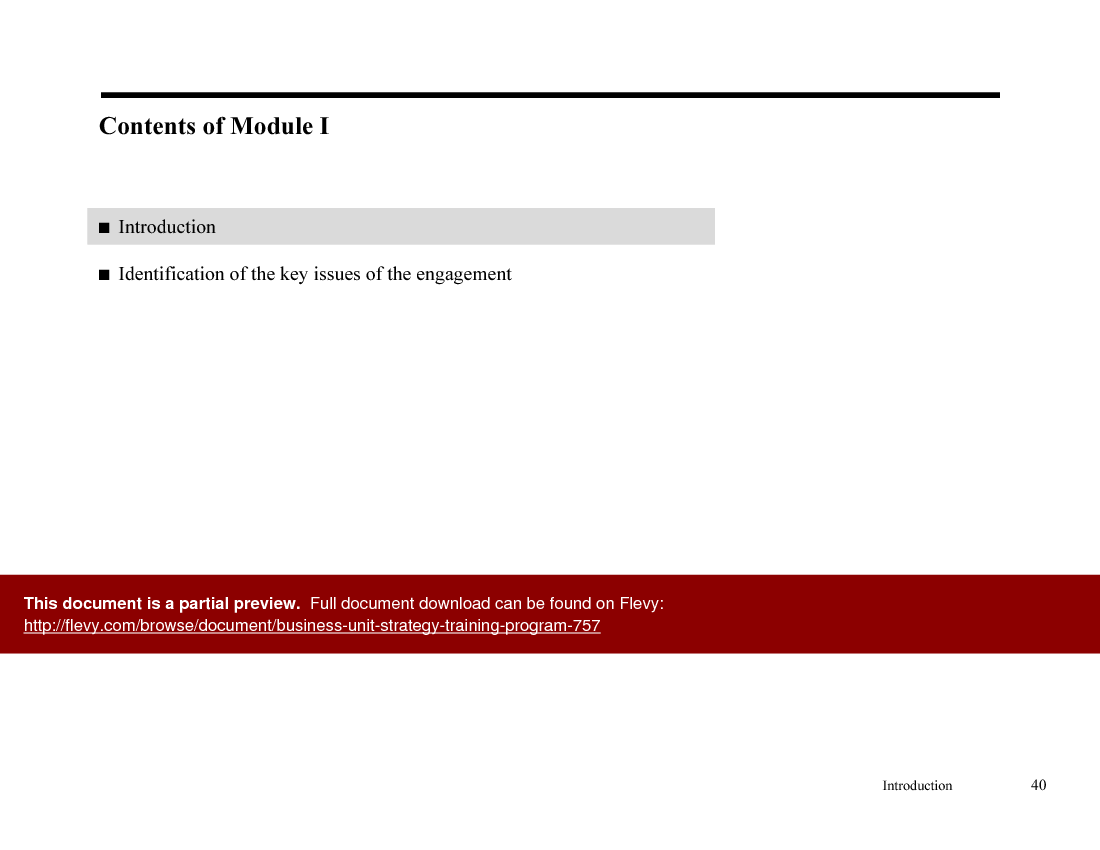
This PPT slide presents a structured approach to hypothesis generation regarding the integration of the client's North Sea business. It outlines key issues and sub-issues that need to be addressed to form a comprehensive hypothesis. The primary question posed is whether the North Sea business should be fully integrated. This is accompanied by several sub-issues that delve deeper into the implications of such integration.
The first sub-issue examines if complete integration would secure maximum vessel capacity. The hypothesis suggests that it would, asserting that integration could optimize resource utilization. Another sub-issue questions whether a controlled unit would ensure the conservation of project generation skills from Business Unit A. The analysis indicates that while integration may enhance capacity, it could also risk sacrificing specific project generation skills in the short term.
The slide also considers the impact of a unified company sales force on maximizing returns. The hypothesis here is affirmative, emphasizing that Business Unit A's superior technology could significantly benefit the North Sea sales force. Lastly, the slide addresses whether combined project management would maintain credibility with multi-client customers. The analysis suggests that project management credibility could be compromised depending on the size of the new organization.
Overall, this slide serves as a framework for developing actionable insights based on the identified issues. It emphasizes the importance of not just stating hypotheses, but also providing a rationale that can be analyzed and validated. This structured approach is crucial for informed decision-making in strategic planning.
Integration of Business Unit Strategy Training Programs
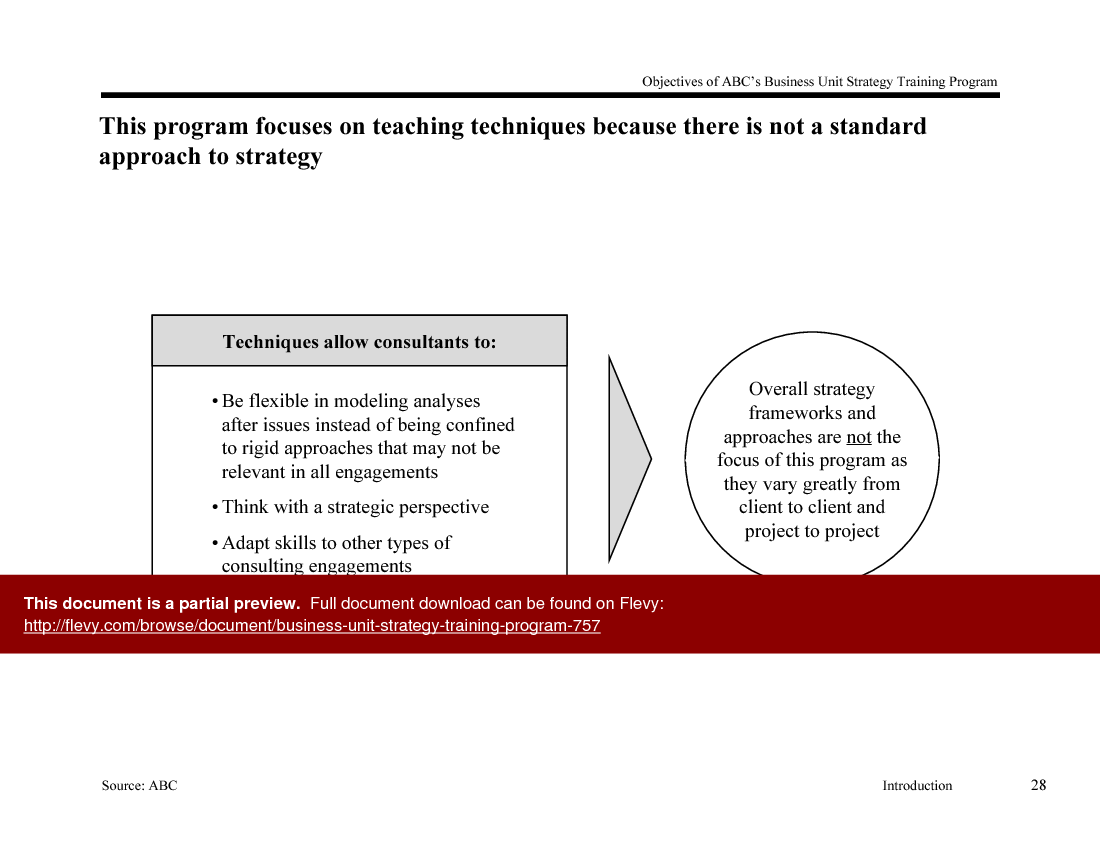
This PPT slide outlines the complementary nature of the Business Unit Strategy Training Program in relation to other major training initiatives within the organization. It features a grid that categorizes various training programs based on specific business processes and target audiences. The horizontal axis lists different roles, including Associate, Manager, Principal, and Officer, while the vertical axis highlights key business processes such as Orientation, Engagement Execution, Engagement Management, Business Development, Account Management, Leadership, and Business Process.
The overlapping areas in the grid indicate where the Business Unit Strategy (BUS) program intersects with other training offerings. For instance, the CEO program is positioned prominently, suggesting its significance in leadership development. The Lead Strategy and Proposal Development (LSPD) program is also central, indicating its relevance across multiple roles.
Each program is represented by abbreviations, such as NCO for New Consultant Orientation and MS for Mind Setting, which implies a structured approach to training that caters to various levels of experience and responsibility. The visual representation serves to clarify how these programs interconnect, providing a roadmap for potential participants to understand which training might be most beneficial for their specific roles and career development paths.
This slide effectively communicates the strategic alignment of training initiatives, emphasizing the importance of a cohesive learning framework that supports organizational goals. It suggests that investing in this training program will enhance not only individual capabilities, but also overall business performance.
Objectives of the Business Unit Strategy Training Program

This PPT slide outlines the primary objectives of the Business Unit Strategy Training Program. Central to the slide is a circular graphic labeled "Goals of the Business Unit Strategy Training Program," which serves as the focal point for the surrounding elements. Each goal is positioned at strategic points around the circle, emphasizing their interconnectedness and relevance to participants.
One key goal is to enhance the capability of the ABC strategy, suggesting a focus on practical application and effectiveness in strategic initiatives. This indicates a commitment to not just theoretical knowledge, but also real-world applicability. Another goal is to develop skills in strategic analysis, which implies that participants will engage in critical thinking and analytical exercises designed to sharpen their decision-making abilities.
Networking is also highlighted as a significant component, encouraging participants to connect with like-minded colleagues. This aspect underscores the importance of collaboration and shared learning in a corporate environment. The slide further emphasizes the value of sharing and testing experiences with others, which can foster a culture of innovation and continuous improvement.
Lastly, the program encourages participants to think about business issues from a strategic perspective, promoting a holistic view of challenges and opportunities. This goal suggests that the training will equip participants with the tools to approach problems creatively and strategically. Overall, the slide effectively communicates the multifaceted nature of the training program, appealing to potential customers by showcasing its comprehensive approach to developing strategic capabilities.
Strategic Evolution of Copypro: 1959-1990
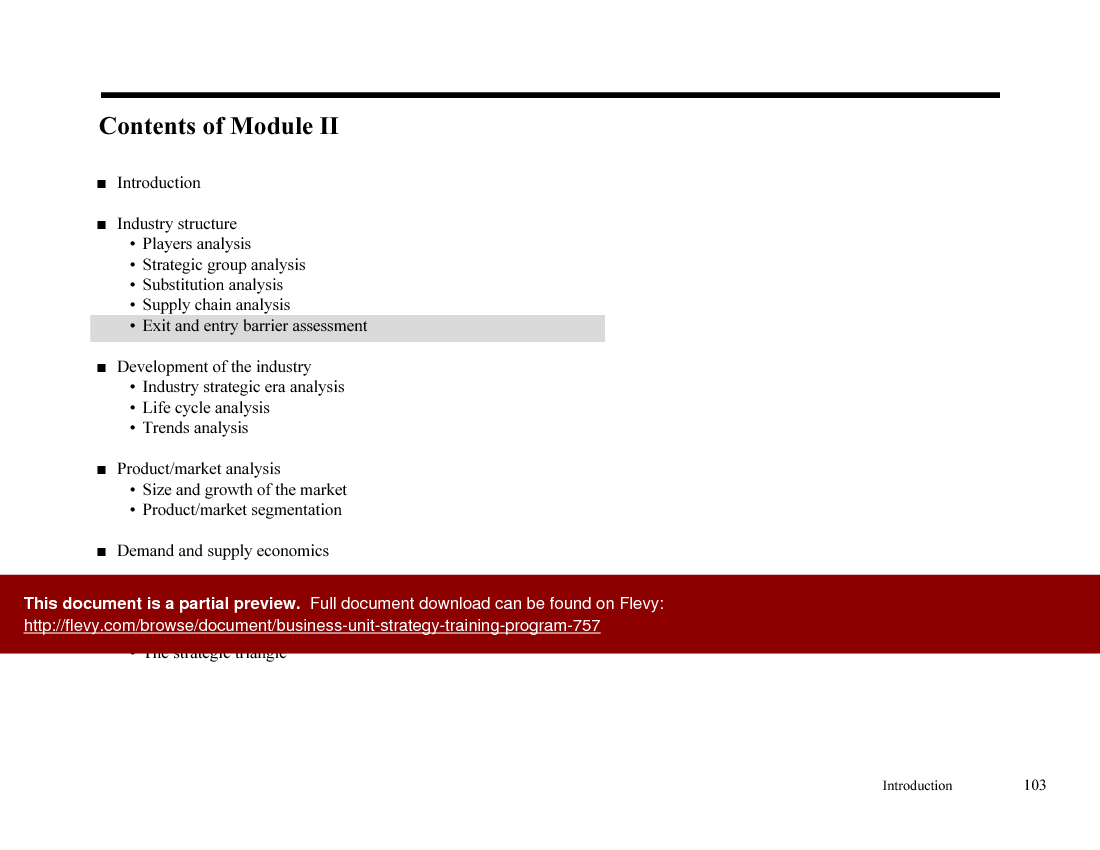
This PPT slide presents a strategic era analysis of a business unit, specifically focusing on Copypro's evolution from 1959 to 1990. It outlines key periods in the company's history, each characterized by distinct strategic themes, key events, and business focuses.
Starting with the "Entry" era in 1959, the primary strategic theme was to build organizational capacity. Key events included establishing an R&D organization dedicated to electro photography and developing low-volume copiers. This foundational phase set the stage for future growth.
The next era, "Internationalization" in 1969, marked a significant shift as Copypro aimed to enter market segments in Japan and Europe, particularly where its competitor, Copycat, was weak. This period saw the introduction of the NP 1100 copier and the launch of the second-generation NP system, indicating a focus on expanding product offerings and geographic reach.
In 1974, during the "Product Development" phase, Copypro expanded its product line, introducing NP color copiers and microprocessor-controlled systems. This era emphasized innovation and the enhancement of product capabilities to meet evolving market demands.
The "Technological Differentiation" era in 1978 aimed to catch up with Copycat by leveraging technological advancements and entering the high-volume market. The introduction of an IT image retention system exemplified this strategic pivot.
Finally, the "Entry into Multimedia" phase in 1990 highlighted Copypro's commitment to supporting its multimedia strategy through the development of advanced digital copying machines and multifunctional devices. This era reflects a broader trend towards integrating technology into product offerings.
Overall, the slide effectively illustrates how Copypro's strategic focus has evolved over time, emphasizing innovation, market expansion, and technological advancement as key drivers of its business strategy.
Strategic Group Analysis of 1980s Food Industry

This PPT slide presents a strategic group analysis framework applied to the food industry during the 1980s. It utilizes a two-dimensional matrix to categorize various companies based on their geographical coverage and marketing intensity. The vertical axis represents geographical coverage, ranging from low to high, while the horizontal axis indicates marketing intensity, from focused to wide.
In the upper right quadrant, labeled "Multinational major brands," companies like Unilever, Danone, and Nestlé are positioned, indicating their extensive geographical reach and broad marketing strategies. This suggests these firms were likely dominant players in the global market during this period. The upper left quadrant, containing "Minor national brands," includes companies like Colmans and ABF, which likely had a more limited geographical presence and marketing focus.
The lower half of the matrix features "National own labels" and "National major brands." The former includes brands like Hillsdown and Booker, which may have concentrated on specific national markets with a narrower marketing approach. The latter, represented by United Biscuits and Unigate, suggests a stronger presence in national markets, but with a broader marketing strategy.
The slide emphasizes that shifts in strategic intent can be effectively captured through this matrix, allowing for a visual representation of how companies adapt over time. This analysis can be particularly useful for understanding market dynamics and positioning strategies within the food industry. It serves as a valuable tool for executives looking to navigate competitive environments and make informed strategic decisions.
Enhancing Strategic Resilience through Scenario Planning
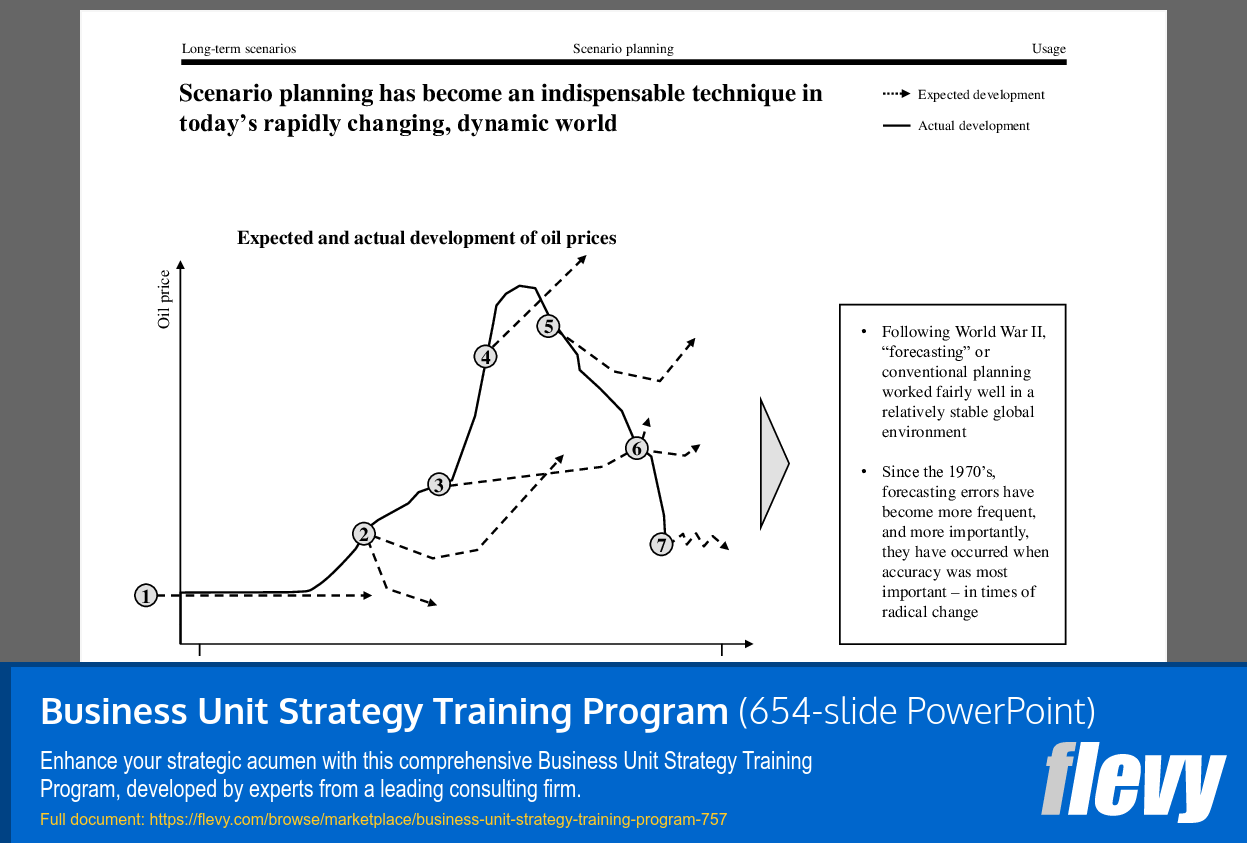
This PPT slide emphasizes the critical role of scenario planning in navigating today's volatile business environment. It presents a graph illustrating the expected versus actual development of oil prices over time, highlighting the discrepancies between projections and reality. The dashed line represents expected developments, while the solid line indicates actual price movements, revealing significant deviations at various points.
The accompanying text provides historical context, noting that after World War II, traditional forecasting methods were effective in a stable global context. However, since the 1970s, the frequency of forecasting errors has increased, particularly during periods of significant change. This suggests that reliance on conventional planning is inadequate in the face of uncertainty. The slide underscores the necessity for organizations to adopt scenario planning as a proactive approach to anticipate and respond to potential market fluctuations.
Key takeaways include the recognition that static forecasting models may not suffice, especially in dynamic markets. The visual representation of oil price trends serves as a cautionary tale for decision-makers, illustrating the unpredictability inherent in economic factors. Companies are encouraged to leverage scenario planning to enhance strategic resilience, enabling them to prepare for multiple potential futures rather than relying solely on linear projections. This approach can foster agility and informed decision-making, essential for thriving amidst uncertainty.
ABOUT THE AUTHOR
Ask the Author a Question
You must be logged in to contact the author.
|
|
"I have used Flevy services for a number of years and have never, ever been disappointed. As a matter of fact, David and his team continue, time after time, to impress me with their willingness to assist and in the real sense of the word. I have concluded in fact ... [read more] that it is not at all just a repository of documents/resources but, in the way that David and his team manage the firm, it is like dealing with consultants always ready to assist, advise and direct you to what you really need, and they always get it right.
"
I am an international hospitality accomplished senior executive who has worked and lived during the past 35 years in 23 countries in 5 continents and I can humbly say that I know what customer service is, trust me. Aside from the great and professional service that Flevy's team provide, their wide variety of material is of utmost great quality, professionally put together and most current. Well done Flevy, keep up the great work and I look forward to continue working with you in the future and to recommend you to a variety of colleagues around the world. – Roberto Pelliccia, Senior Executive in International Hospitality
|
|
|
"[Flevy] produces some great work that has been/continues to be of immense help not only to myself, but as I seek to provide professional services to my clients, it gives me a large "tool box" of resources that are critical to provide them with the quality of service and outcomes they are expecting."
– Royston Knowles, Executive with 50+ Years of Board Level Experience
|
|
|
"My FlevyPro subscription provides me with the most popular frameworks and decks in demand in today’s market. They not only augment my existing consulting and coaching offerings and delivery, but also keep me abreast of the latest trends, inspire new products and service offerings for my practice, and educate me ... [read more] in a fraction of the time and money of other solutions. I strongly recommend FlevyPro to any consultant serious about success. "
– Bill Branson, Founder at Strategic Business Architects
|
|
|
"If you are looking for great resources to save time with your business presentations, Flevy is truly a value-added resource. Flevy has done all the work for you and we will continue to utilize Flevy as a source to extract up-to-date information and data for our virtual and onsite presentations!"
– Debbi Saffo, President at The NiKhar Group
|
|
|
"Last Sunday morning, I was diligently working on an important presentation for a client and found myself in need of additional content and suitable templates for various types of graphics. Flevy.com proved to be a treasure trove for both content and design at a reasonable price, considering the time I ... [read more] saved. I encountered a download issue during the ordering process. However, a quick email to Flevy's support team, even on a Sunday (!!!), resulted in assistance within less than an hour, allowing me to download the content I needed. Fantastic job, Flevy! I give 5 stars for both content/price and customer service. Thank you! "
– M. E., Chief Commercial Officer, International Logistics Service Provider
|
|
|
"FlevyPro has been a brilliant resource for me, as an independent growth consultant, to access a vast knowledge bank of presentations to support my work with clients. In terms of RoI, the value I received from the very first presentation I downloaded paid for my subscription many times over! The ... [read more] quality of the decks available allows me to punch way above my weight – it's like having the resources of a Big 4 consultancy at your fingertips at a microscopic fraction of the overhead. "
– Roderick Cameron, Founding Partner at SGFE Ltd
|
|
|
"As an Independent Management Consultant, I find Flevy to add great value as a source of best practices, templates and information on new trends. Flevy has matured and the quality and quantity of the library is excellent. Lastly the price charged is reasonable, creating a win-win value for ... [read more] the customer, Flevy and the various authors. This is truly a service that benefits the consulting industry and associated clients. Thanks for providing this service. "
– Jim Schoen, Principal at FRC Group
|
|
|
"Flevy is our 'go to' resource for management material, at an affordable cost. The Flevy library is comprehensive and the content deep, and typically provides a great foundation for us to further develop and tailor our own service offer."
– Chris McCann, Founder at Resilient.World
|
